Thermal Energy Transfer
Decoding the Thermodynamic Secrets of Heat Pumps

Are you interested in understanding how heat pumps work, effectively transferring thermal energy to keep spaces warm in the winter and cool in the summer? Join us as we explore the thermodynamic principles that allow these amazing devices to operate.
Through our research and analysis, we will unravel the principles of heat pump operation, explore the role of refrigerants, and delve into the science of heat transfer.
Prepare to be amazed by the intricate dance of thermodynamics as we uncover the inner workings of heat pumps.
Key Takeaways
- The efficiency of heat pumps is influenced by the choice of refrigerant, with optimal refrigerant types maximizing efficiency.
- Traditional refrigerants contribute to ozone depletion and global warming, leading to regulations and a push for alternative refrigerants with lower environmental impact.
- Understanding thermodynamics is crucial for efficient heat transfer in heat pump operation, which involves the absorption, compression, and release of heat.
- Maximizing heat pump performance and efficiency can be achieved through the use of advanced heat exchangers, minimizing heat losses, proper system design, and insulation to minimize heat loss and maintain consistent temperature.
The Basics of Thermal Energy Transfer in Heat Pumps
In this section, we’ll explore the basics of thermal energy transfer in heat pumps. Understanding thermal energy efficiency and heat pump operation principles is essential for serving others in the field of heat pump technology.
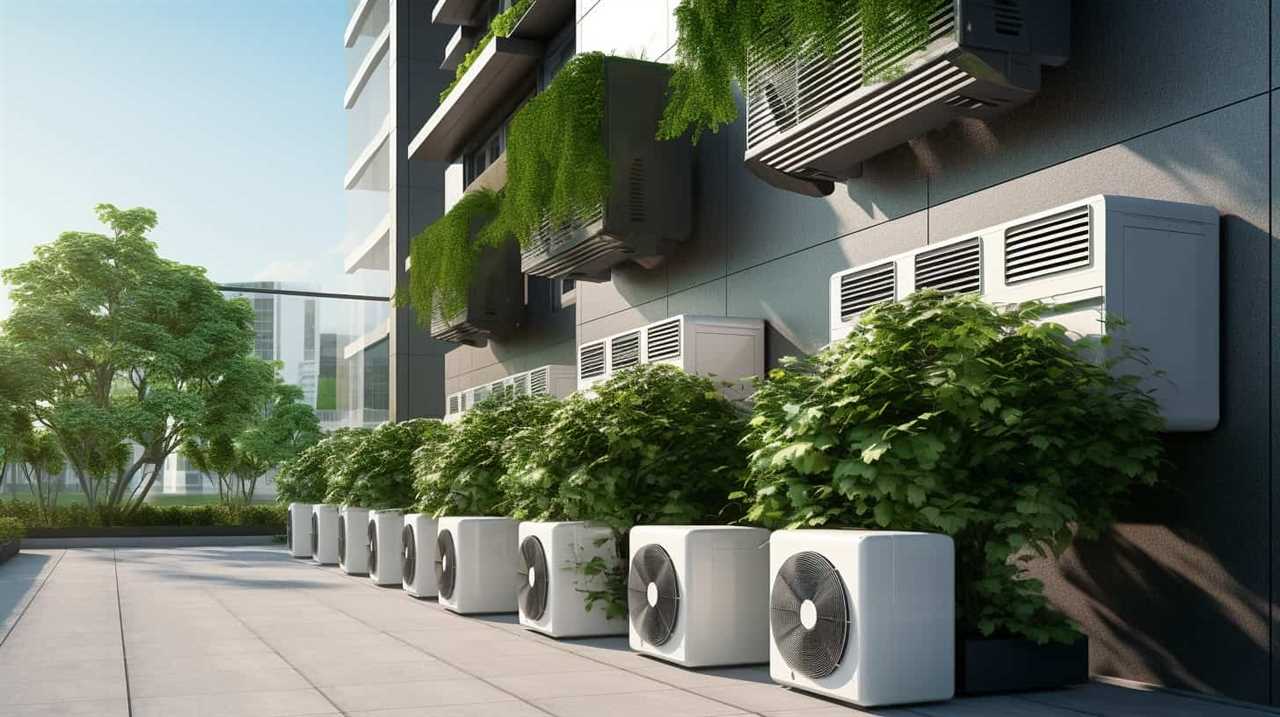
Thermal energy transfer in heat pumps is based on the principle of moving heat from a low-temperature source to a high-temperature sink. This process is achieved by utilizing a refrigerant that undergoes phase changes, such as evaporation and condensation.
The heat pump system consists of four main components: the evaporator, compressor, condenser, and expansion valve. The evaporator absorbs heat energy from the low-temperature source, while the compressor increases the pressure and temperature of the refrigerant.
The condenser releases the heat to the high-temperature sink, and the expansion valve regulates the flow of the refrigerant. By understanding these fundamental principles, we can optimize the thermal energy efficiency of heat pumps and ensure effective heat transfer for the benefit of those we serve.
Understanding the Role of Refrigerants in Heat Pump Efficiency
When it comes to heat pump efficiency, the choice of refrigerant plays a crucial role. Optimal refrigerant types can significantly impact the overall performance and energy efficiency of heat pumps.

It’s important to consider not only the thermodynamic properties of the refrigerant but also its environmental impact, as certain refrigerants have been found to contribute to ozone depletion or global warming.
Therefore, understanding the role of refrigerants in heat pump efficiency requires a careful examination of both their technical characteristics and their environmental implications.
Optimal Refrigerant Types
Our research indicates that selecting the optimal refrigerant type is crucial in maximizing heat pump efficiency. When it comes to energy efficiency and operating costs, the choice of refrigerant plays a significant role. Different refrigerants have varying thermodynamic properties, which directly impact the heat pump’s performance. By carefully considering factors such as heat transfer ability, environmental impact, and cost-effectiveness, one can choose the most suitable refrigerant for their heat pump system.
Energy efficiency is a key consideration when selecting a refrigerant. Some refrigerants have higher heat transfer coefficients, allowing for more efficient heat exchange and better overall performance. Additionally, refrigerants with lower global warming potential and ozone depletion potential are preferable from an environmental standpoint.

Operating costs are another critical factor to consider. The cost of the refrigerant itself, as well as maintenance and disposal expenses, can significantly impact the lifetime cost of the heat pump system. By choosing a refrigerant that’s readily available and cost-effective, users can minimize their operating costs and maximize the system’s efficiency.
Environmental Impact of Refrigerants
By understanding the environmental impact of refrigerants, we can better comprehend their role in heat pump efficiency. The choice of refrigerant has a significant impact on the overall environmental performance of a heat pump system.
Traditionally used refrigerants, such as chlorofluorocarbons (CFCs) and hydrochlorofluorocarbons (HCFCs), have been found to contribute to ozone depletion and global warming. As a result, regulations and policies have been implemented to phase out the use of these harmful substances.
In response, the industry has been actively researching and developing alternative refrigerants that have lower environmental impact. These refrigerant alternatives, such as hydrofluorocarbons (HFCs) and natural refrigerants like carbon dioxide (CO2) and ammonia (NH3), have been gaining popularity due to their lower global warming potential.
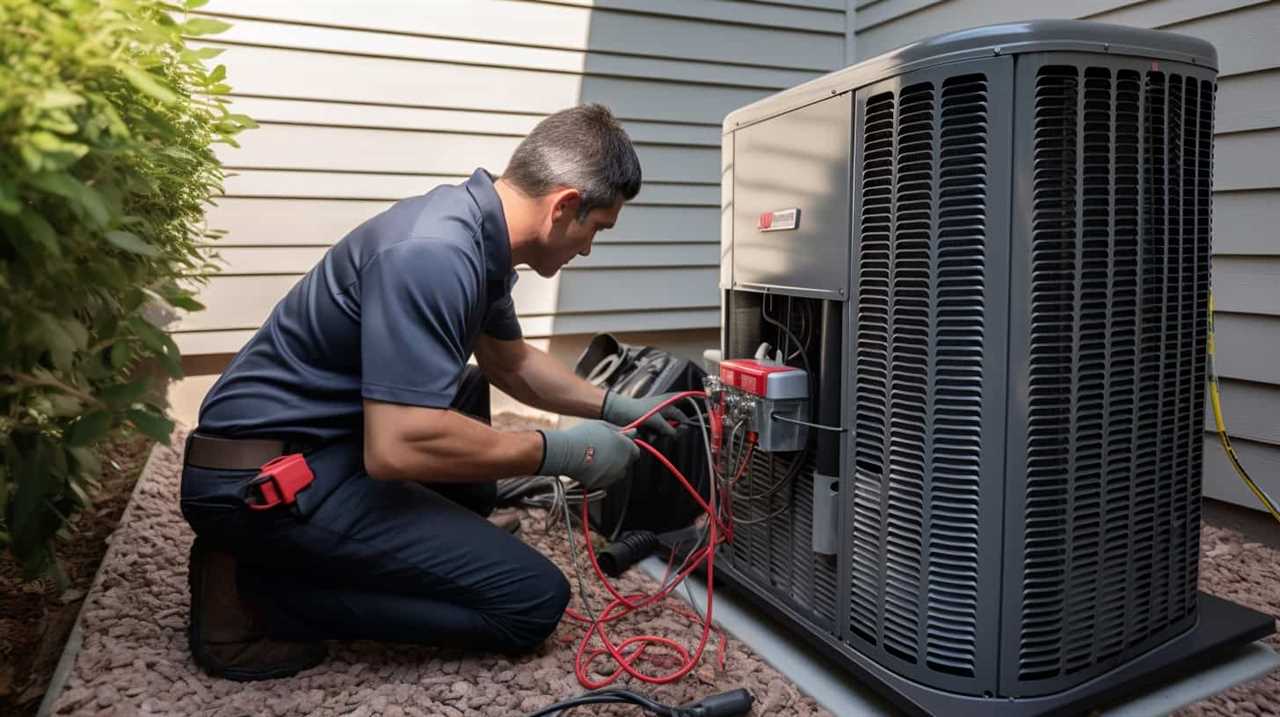
However, it’s important to note that while these alternatives have reduced environmental impact, they may still have their own drawbacks and trade-offs in terms of performance and safety. Therefore, proper selection and management of refrigerants, in accordance with regulations and policies, is crucial for maximizing heat pump efficiency while minimizing environmental impact.
Exploring the Principles of Thermodynamics in Heat Pump Operation
The principles of thermodynamics in heat pump operation can be explored to understand how these systems efficiently transfer heat.
One important aspect of heat pump operation is thermal energy storage, which allows for the storage and use of excess heat or cold for later use. This can be beneficial for homes or buildings that require heating or cooling at different times of the day.
Another crucial factor in heat pump operation is proper maintenance. Regular maintenance ensures that the system is operating at peak efficiency, reducing energy consumption and extending the lifespan of the heat pump. This includes tasks such as cleaning or replacing filters, checking refrigerant levels, and inspecting electrical connections.

The Science Behind Heat Pump Heat Transfer
When it comes to heat pump heat transfer, there are several key points to consider.
First, efficient heat transfer methods play a crucial role in the overall performance of the heat pump system. This involves the effective transfer of heat from one medium to another, such as from the outdoor air to the indoor space.
Second, the choice and properties of the refrigerants used in heat pumps are important factors that impact heat transfer efficiency.
Lastly, it’s crucial to consider the environmental impact of the heat pump system, including the potential for refrigerant leaks and the overall energy efficiency of the system.

Efficient Heat Transfer Methods
We frequently employ efficient heat transfer methods to maximize the effectiveness of heat pump heat transfer. One such method is the use of advanced heat exchangers.
These heat exchangers are designed to efficiently transfer heat between the heat source and the heat sink. They’re constructed using materials with high thermal conductivity and are optimized to minimize heat losses through factors such as conduction, convection, and radiation.
Additionally, advanced heat exchangers often incorporate features such as fins or turbulators to increase the surface area and enhance heat transfer.
Role of Refrigerants
Refrigerants play a crucial role in the science behind heat pump heat transfer. They are the lifeblood of heat pumps, responsible for the transfer of heat energy from one location to another. Their properties determine the efficiency and effectiveness of the heat transfer process.

Here are four key ways refrigerants contribute to the science of heat pump heat transfer:
-
Thermodynamic properties: Refrigerants possess specific properties that allow them to change states at desired temperatures, absorbing and releasing heat energy in the process.
-
Heat capacity: The ability of a refrigerant to store and transfer heat is essential for efficient heat pump operation.
-
Pressure-temperature relationship: Refrigerants undergo phase changes at specific pressures and temperatures, enabling heat transfer between the indoor and outdoor environments.

-
Environmental impact: Careful refrigerant selection is crucial to minimize the carbon footprint of heat pumps and contribute to sustainable practices.
Environmental Impact Considerations
Minimizing the environmental impact of heat pump heat transfer requires considering the lifecycle emissions and disposal of refrigerants. To reduce the carbon footprint associated with heat pumps, it’s crucial to explore sustainable refrigerant alternatives that have lower global warming potential (GWP) and ozone depletion potential (ODP) compared to traditional refrigerants.
These alternatives aim to mitigate the negative environmental effects caused by the release of refrigerants into the atmosphere. By adopting sustainable refrigerants, we can significantly contribute to carbon footprint reduction and protect the ozone layer.
Additionally, proper disposal and recycling of refrigerants at the end of their lifecycle are essential to prevent further harm to the environment. Transitioning to sustainable refrigerant alternatives is a significant step towards achieving a more environmentally friendly heat pump industry.

Now, let’s delve into the next section to unveil the secrets of heat pump compressors.
Unveiling the Secrets of Heat Pump Compressors
By understanding the inner workings of heat pump compressors, we can unlock the secrets to their thermodynamic efficiency. These vital components play a crucial role in the overall performance of heat pumps. Here are four key aspects to consider when it comes to heat pump compressors:
-
Regular maintenance: Proper maintenance is essential for optimal compressor performance. Regularly cleaning and inspecting the compressor can help identify any potential issues and prevent costly breakdowns.
-
Troubleshooting techniques: When troubleshooting a heat pump, it’s important to check the compressor for any signs of damage or malfunction. Understanding common compressor problems and employing effective troubleshooting techniques can help identify and resolve issues promptly.
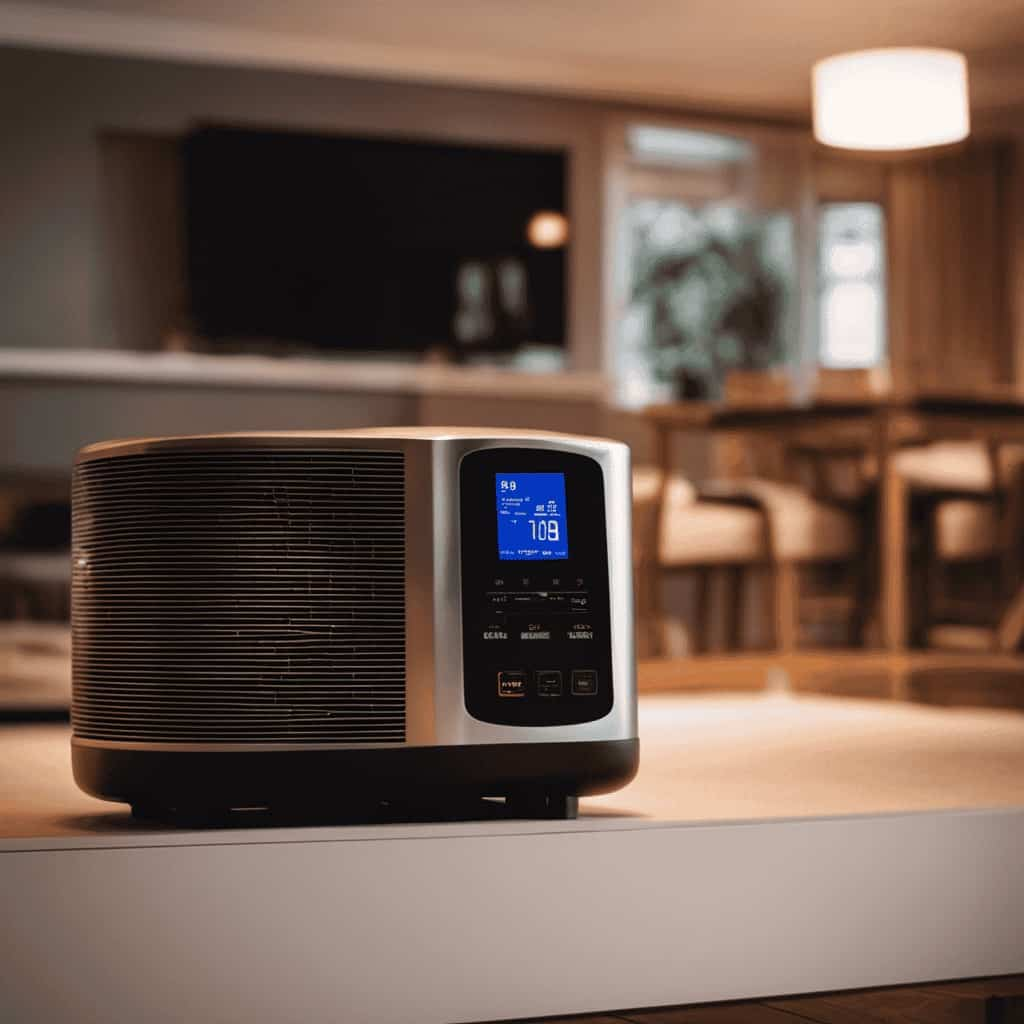
-
Compressor capacity: The capacity of the compressor should be matched with the heat pump system’s heating and cooling needs. An oversized or undersized compressor can lead to inefficiencies and decreased performance.
-
Compressor technology: Advancements in compressor technology, such as variable speed compressors, can significantly improve energy efficiency and overall system performance.
Maximizing Heat Pump Performance Through Optimal System Design
To maximize heat pump performance, we must prioritize optimal system design. Achieving maximum energy efficiency and heat pump optimization requires careful consideration of various factors such as sizing, layout, and component selection. A well-designed heat pump system can significantly reduce energy consumption, lower operating costs, and enhance overall performance.
When it comes to maximizing energy efficiency, one crucial aspect is proper sizing. Undersized or oversized systems can lead to inefficiencies and decreased performance. By conducting a thorough analysis of the heating and cooling load requirements, we can determine the appropriate system size that matches the specific needs of the building.
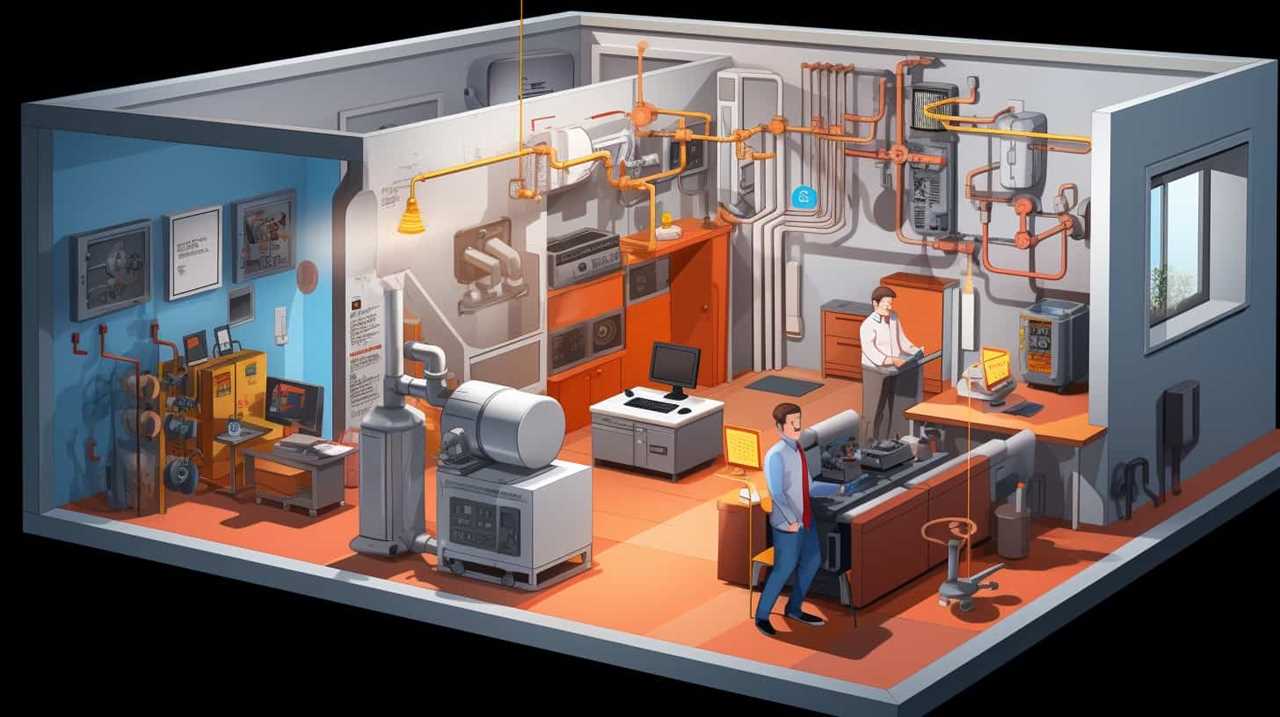
Layout and component selection also play a vital role in heat pump optimization. A well-designed system should minimize the distance and number of bends in the refrigerant lines, ensuring efficient heat transfer and reducing energy losses. Additionally, selecting high-quality components, such as advanced compressors and heat exchangers, can enhance system efficiency and overall performance.
The Importance of Insulation in Heat Pump Efficiency
Insulation plays a crucial role in maximizing heat pump efficiency and achieving energy savings. Proper insulation helps to minimize heat loss and maintain a consistent temperature within the system, allowing the heat pump to operate more efficiently.
On the other hand, poor insulation can lead to significant energy losses, reducing the overall efficiency of the heat pump and increasing energy consumption.
Insulation and Energy Savings
We can enhance heat pump efficiency by improving insulation in our homes. Effective insulation helps to minimize heat loss or gain, providing a stable indoor temperature and reducing the workload on the heat pump.

Here are four key ways in which insulation contributes to energy savings:
-
Energy efficient materials: Using insulation materials with high R-values, such as fiberglass or cellulose, helps to trap heat and prevent it from escaping or entering the home, reducing the need for constant heating or cooling.
-
Proper insulation techniques: Ensuring airtightness by sealing gaps and cracks in walls, windows, and doors prevents air leakage, thereby reducing energy loss and improving overall energy efficiency.
-
Thermal bridging prevention: By addressing areas where heat can bypass insulation, such as studs or joists, thermal bridging is minimized, leading to increased energy savings.
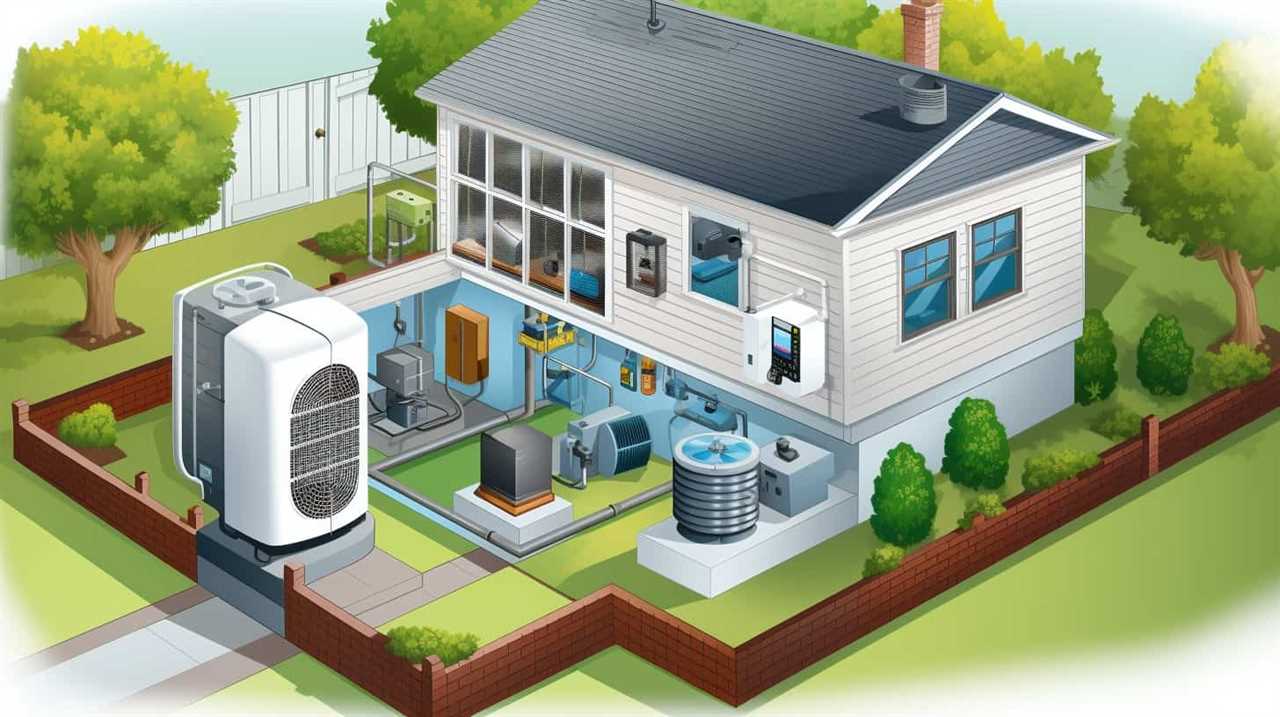
-
Attic and roof insulation: Insulating the attic and roof areas effectively helps to maintain a consistent indoor temperature, reducing the need for excessive heating or cooling.
Impact of Poor Insulation
By neglecting proper insulation, we risk compromising the efficiency of our heat pumps over time. Inadequate insulation can lead to significant energy loss and increased cost implications.
Insulation plays a vital role in preventing heat transfer between the indoor and outdoor environments. Without sufficient insulation, heat can escape or enter our homes, making our heat pumps work harder to maintain the desired temperature. This increased workload not only reduces the overall efficiency of the heat pump but also leads to higher energy consumption and utility bills.
Additionally, poor insulation can result in temperature fluctuations, discomfort, and reduced indoor air quality.

To ensure optimal heat pump performance and minimize energy loss, it’s crucial to invest in proper insulation that meets industry standards and effectively seals any potential areas of heat transfer.
The Impact of Climate on Heat Pump Operation
Since climate plays a significant role in the operation of heat pumps, it’s important to understand how different weather conditions can affect their efficiency and performance. Here are four key ways in which climate can impact heat pump operation:
-
Temperature: Heat pumps work by transferring heat from one place to another. In colder climates, heat pumps have to work harder to extract heat from the outside air, reducing their efficiency and increasing energy consumption.
-
Humidity: High humidity levels can affect the heat transfer process in heat pumps, making it more difficult for them to extract heat from the air. This can result in reduced performance and higher energy consumption.

-
Extreme Weather Events: Heat pumps may struggle to operate efficiently during extreme weather events such as hurricanes or heatwaves. These events can put additional stress on the system and affect its ability to maintain desired indoor temperatures.
-
Climate Change: As climate change leads to more frequent and extreme weather conditions, heat pump operation may be further impacted. Rising temperatures, changing humidity levels, and increased frequency of extreme weather events can all affect the efficiency and performance of heat pumps.
Understanding the impact of climate on heat pump operation is crucial for optimizing their efficiency, reducing energy consumption, and providing optimal comfort for users. By considering these factors, we can better serve our customers and address the challenges posed by climate change.
Troubleshooting Common Issues in Heat Pump Thermal Energy Transfer
When troubleshooting common issues in heat pump thermal energy transfer, it’s important to identify and address any factors that may be hindering the efficiency and performance of the system.
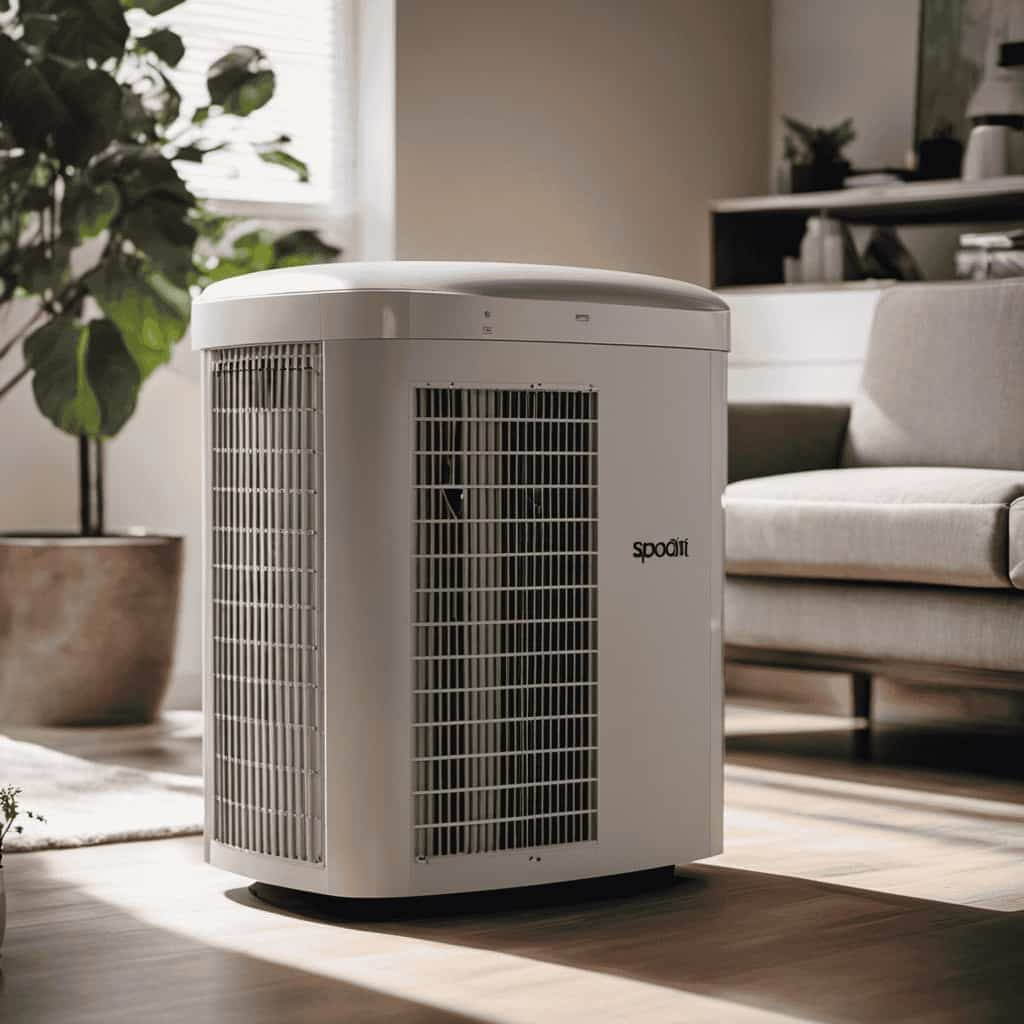
To begin, implementing effective troubleshooting techniques can help diagnose and resolve problems. One such technique is conducting a thorough inspection of the heat pump components, including the compressor, condenser, and evaporator. This can help identify any mechanical or electrical issues that may be affecting the transfer of thermal energy.
Additionally, regular maintenance is crucial to ensure optimal heat pump performance. This includes cleaning or replacing air filters, checking refrigerant levels, and lubricating moving parts.
The Future of Heat Pumps: Advancements in Thermal Energy Transfer Technology
We anticipate significant advancements in thermal energy transfer technology that will shape the future of heat pumps. These advancements will enable heat pumps to become more efficient, reliable, and environmentally friendly.
Here are four key areas where we expect to see progress:

-
Advancements in renewable energy sources: Heat pumps will become more compatible with renewable energy systems, such as solar and wind power, allowing for greater sustainability and reduced reliance on fossil fuels.
-
Integration of smart technology: Heat pumps will be equipped with advanced sensors and control systems, enabling them to optimize their performance based on factors such as weather conditions and energy demand. This will result in higher efficiency and lower energy consumption.
-
Enhanced heat exchanger design: Improvements in heat exchanger technology will increase heat transfer efficiency, improving the overall performance of heat pumps and reducing energy wastage.
-
Development of advanced refrigerants: New refrigerants with lower global warming potential will be introduced, minimizing the environmental impact of heat pumps and ensuring compliance with evolving regulations.
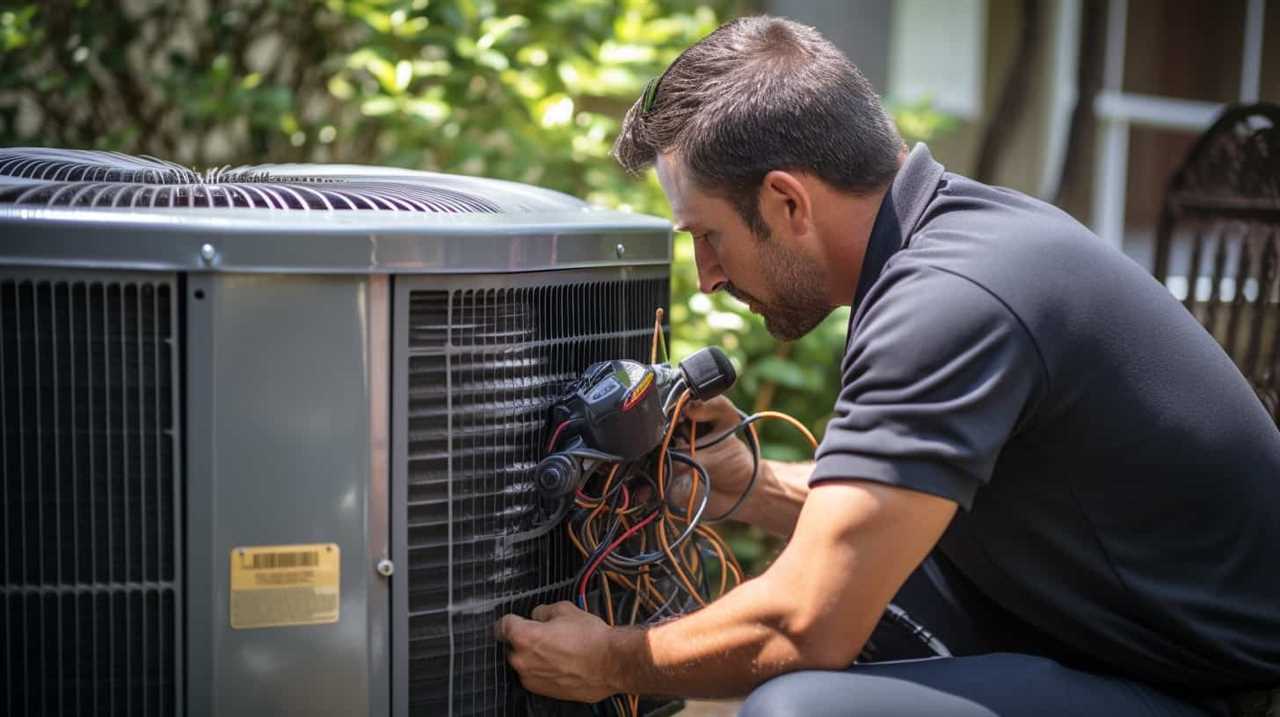
With these advancements, heat pumps will play a crucial role in providing sustainable and efficient heating and cooling solutions for a greener future.
Frequently Asked Questions
How Long Does It Take for a Heat Pump to Cool Down or Heat up a Room?
It takes a heat pump a variable amount of time to cool down or heat up a room, depending on factors such as room size, insulation, and desired temperature. Heat pump efficiency can lead to energy saving benefits.
Can a Heat Pump Be Used in Extreme Weather Conditions?
In extreme weather conditions, using a heat pump presents challenges to its efficiency. However, by understanding the thermodynamic secrets and implementing innovative solutions, we can optimize its performance and serve others effectively.
What Is the Lifespan of a Typical Heat Pump?
The lifespan of a typical heat pump depends on various factors, including regular maintenance, usage patterns, and environmental conditions. Factors that can affect heat pump efficiency and lifespan include proper installation, proper sizing, and regular cleaning and servicing.

Are There Any Government Incentives or Rebates Available for Installing a Heat Pump?
There are government incentives and rebates available for installing a heat pump. These incentives aim to promote energy savings and help individuals make environmentally friendly choices.
How Much Maintenance Is Required for a Heat Pump and What Are the Associated Costs?
Maintaining a heat pump involves regular inspections, filter changes, and cleaning. These maintenance tasks are essential for optimal performance and energy efficiency. The associated costs of maintenance can vary depending on the specific requirements of the heat pump.
Conclusion
As we delve into the intricacies of heat pumps and their thermodynamic secrets, we uncover a world of possibilities for efficient thermal energy transfer.
Like a well-orchestrated symphony, the principles of thermodynamics, refrigerants, compressors, insulation, and climate all work together to create the harmonious melody of heat pump operation.
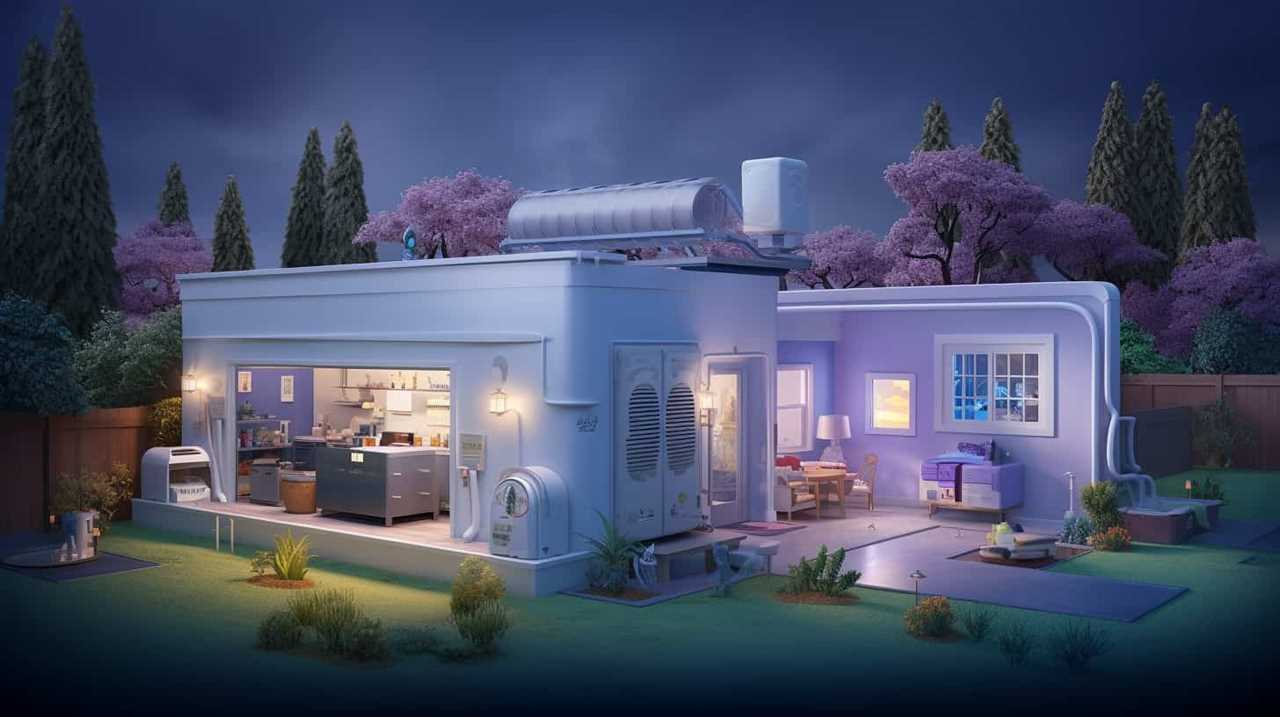
With advancements in thermal energy transfer technology on the horizon, the future of heat pumps holds promise for a more sustainable and environmentally-friendly way to heat and cool our spaces.
Thermal Energy Transfer
Why Thermal Energy Transfer Matters in Heat Pumps

Discovering the world of heat pumps, we are captivated by the intricate dance of thermal energy transfer. This vital process, often overlooked, is key to maximizing heat pump efficiency.
With our technical lenses on, we aim to unravel the importance of efficient heat transfer and its impact on the functionality of heat pump components.
Join us as we explore the fascinating realm of thermal energy transfer and its role in serving you better.
Key Takeaways
- Thermal energy transfer is crucial for the efficient performance of heat pumps.
- Efficient heat transfer leads to significant energy savings and reduces the environmental impact associated with energy consumption.
- Well-designed heat pumps with efficient energy transfer reduce overall heating and cooling costs.
- Optimizing heat transfer efficiency helps mitigate climate change by reducing greenhouse gas emissions and promoting the use of renewable energy sources.
The Basics of Thermal Energy Transfer in Heat Pumps
In our article, we’ll now delve into the basics of thermal energy transfer in heat pumps. Exploring heat pump design and understanding thermodynamics are crucial for comprehending the principles behind this process.

Heat pumps are devices that transfer thermal energy from a lower temperature source to a higher temperature sink, using external work as the driving force. This transfer is made possible by the working fluid within the heat pump, which undergoes a cycle involving evaporation, compression, condensation, and expansion.
During evaporation, the working fluid absorbs thermal energy from the low-temperature source, causing it to vaporize. The compressed vapor then releases thermal energy to the high-temperature sink during condensation.
Understanding the Importance of Efficient Heat Transfer
Efficient heat transfer is crucial in heat pumps for several reasons.
Firstly, it directly influences the performance of the heat pump, allowing it to effectively transfer thermal energy from one location to another. This means that with more efficient heat transfer, the heat pump can provide better heating or cooling capabilities.

Secondly, efficient heat transfer in heat pumps can lead to significant energy savings, as less energy is wasted during the heating or cooling process.
Lastly, by improving heat transfer efficiency, heat pumps can contribute to reducing the environmental impact associated with energy consumption, helping to mitigate climate change and promote sustainability.
Effective Heat Pump Performance
Our main goal is to maximize the heat pump’s performance by ensuring optimal heat transfer.
Effective heat pump performance depends on various factors, including energy efficiency and heat pump design. Energy efficiency plays a crucial role in determining the overall effectiveness of a heat pump. A well-designed heat pump with efficient energy transfer can significantly reduce energy consumption and operating costs while maintaining a comfortable indoor environment.
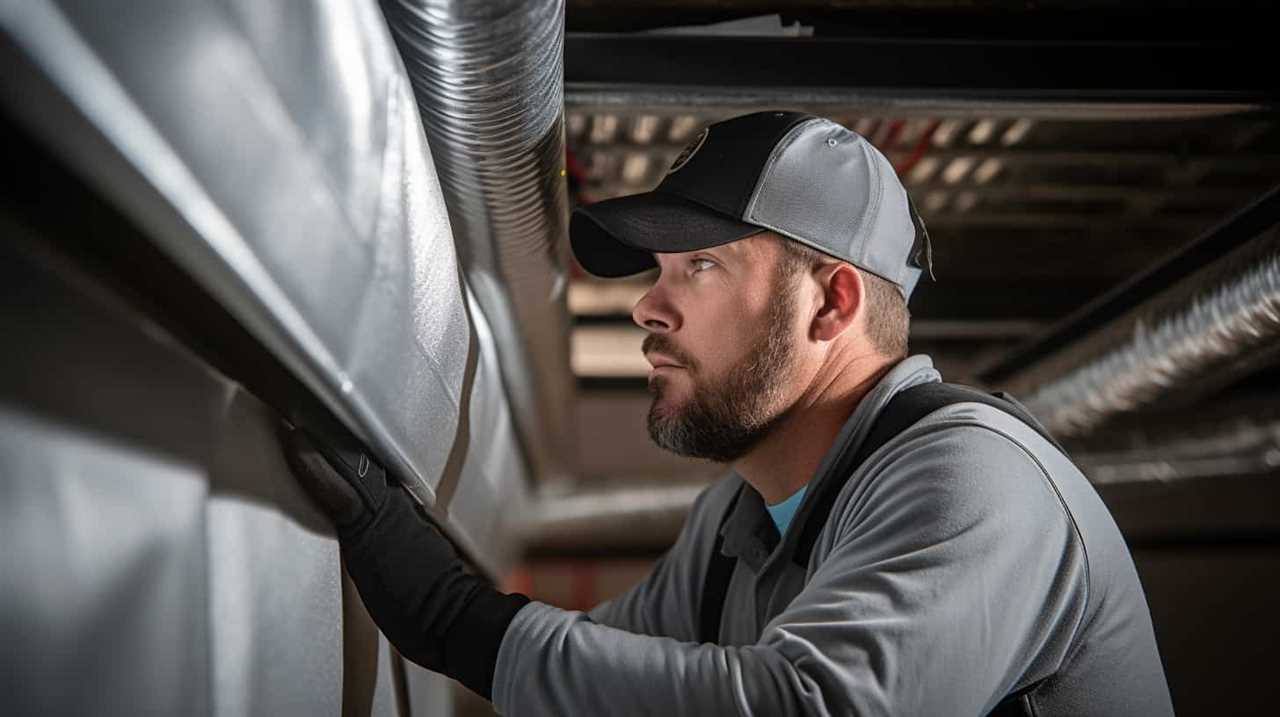
By maximizing the transfer of thermal energy, heat pumps can efficiently extract heat from the air or ground and transfer it to provide heating or cooling. This ensures that the heat pump operates at its highest potential, delivering optimal performance and maximizing energy savings.
Understanding the importance of efficient heat transfer is essential for achieving effective heat pump performance and meeting the needs of those we serve.
Energy Savings Potential
By optimizing heat transfer efficiency, we can unlock the full potential of energy savings in heat pumps. Energy efficiency is crucial when it comes to reducing the overall cost of heating and cooling systems. Efficient heat transfer ensures that the heat pump can effectively extract and transfer thermal energy from one location to another, resulting in reduced energy consumption and lower utility bills.
When heat transfer is optimized, heat pumps can operate more efficiently, requiring less energy input to achieve the desired heating or cooling effect. This translates to significant cost savings for homeowners and businesses alike. By investing in heat pump systems that prioritize energy efficiency and effective heat transfer, we can maximize the potential for financial savings over the long term.

As we strive to reduce our environmental impact, energy savings through efficient heat transfer play a vital role. By minimizing energy consumption, we can decrease greenhouse gas emissions and contribute to a more sustainable future.
In the next section, we’ll explore how optimizing heat transfer efficiency can further enhance our efforts in reducing environmental impact.
Environmental Impact Reduction
Let’s delve into how optimizing heat transfer efficiency can contribute to reducing our environmental impact. By improving the efficiency of heat transfer in heat pumps, we can achieve significant reductions in our carbon footprint and promote the integration of renewable energy sources.
Here are four key reasons why efficient heat transfer is crucial for environmental impact reduction:
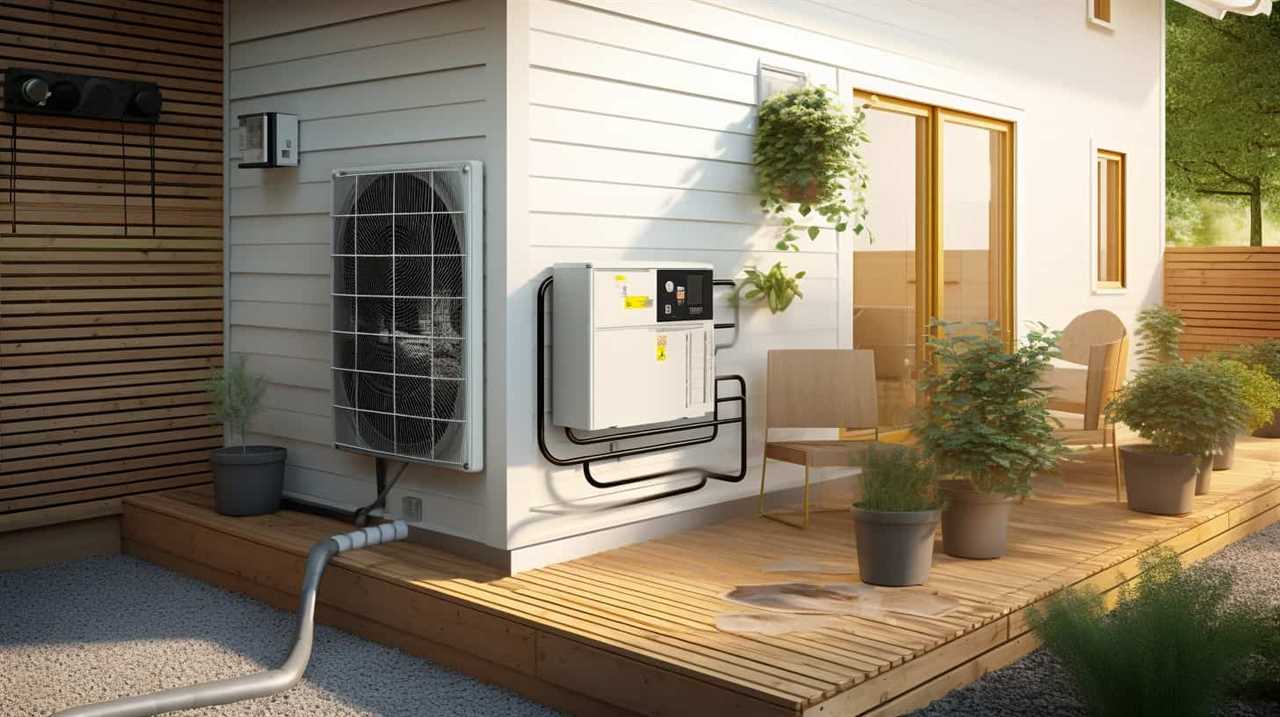
-
Energy savings: Efficient heat transfer allows heat pumps to use less energy, resulting in reduced demand for fossil fuels and lower greenhouse gas emissions.
-
Increased renewable energy integration: With improved heat transfer efficiency, heat pumps can effectively harness energy from renewable sources such as solar or geothermal, further reducing reliance on non-renewable energy.
-
Lower operating costs: Optimizing heat transfer minimizes energy waste, leading to reduced energy consumption and lower utility bills for users.
-
Environmental preservation: By reducing our carbon footprint, efficient heat transfer helps protect the environment and mitigate the impacts of climate change.
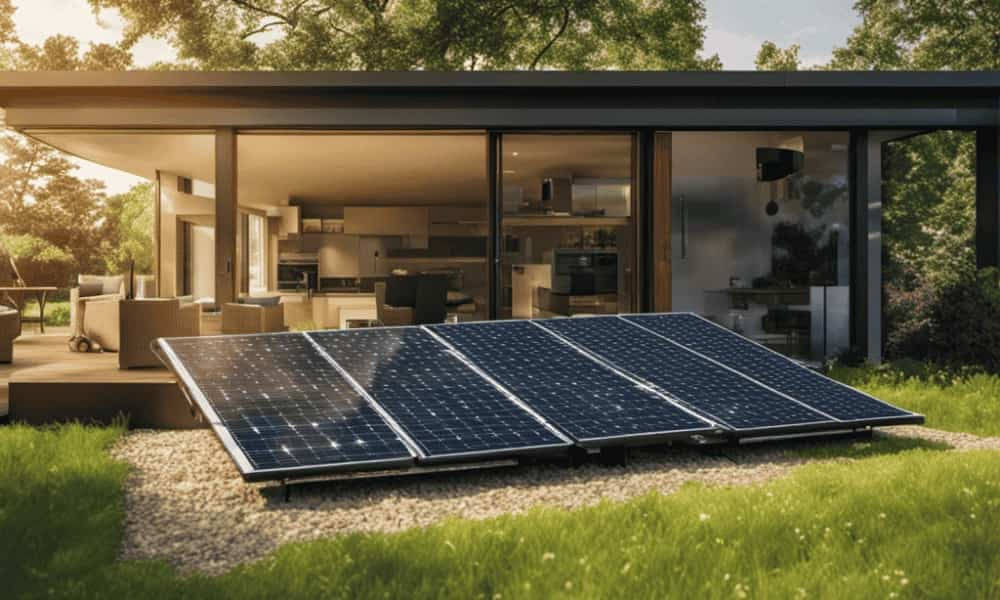
Understanding the importance of efficient heat transfer is essential for achieving sustainable and environmentally-friendly heating and cooling solutions.
Now, let’s explore the role of thermal energy transfer in heat pump efficiency.
The Role of Thermal Energy Transfer in Heat Pump Efficiency
Thermal energy transfer plays a crucial role in maximizing heat pump efficiency. When it comes to heat pump design, understanding the principles of thermal energy transfer is essential for achieving optimal performance.
Heat pumps work by transferring thermal energy from a low-temperature source to a high-temperature sink. The efficiency of this process depends on the ability to transfer heat effectively. This is achieved through the use of refrigerants, which absorb and release heat as they change from a gas to a liquid and vice versa.

Maximizing heat transfer efficiency involves careful selection of refrigerants and the design of heat exchangers to facilitate the transfer of thermal energy. By optimizing these factors, heat pumps can achieve higher efficiency, resulting in reduced energy consumption and lower operating costs.
Factors Affecting Thermal Energy Transfer in Heat Pumps
Two main factors that affect thermal energy transfer in heat pumps are the temperature difference between the source and sink, and the efficiency of the heat exchangers. These factors play a crucial role in the overall performance and effectiveness of heat pump systems.
To better understand these factors, consider the following:
-
Temperature difference: The greater the temperature difference between the source and sink, the more heat can be transferred. This is because heat naturally flows from areas of high temperature to areas of low temperature. By maximizing the temperature difference, heat pumps can efficiently transfer thermal energy.

-
Efficiency of heat exchangers: Heat exchangers are responsible for facilitating the transfer of thermal energy between the source and sink. The efficiency of these components determines how effectively heat is transferred. Advancements in heat pump technology have led to improvements in heat exchanger design, resulting in higher thermal conductivity and more efficient heat transfer.
-
Heat pump technology advancements: Ongoing advancements in heat pump technology have led to more efficient and effective systems. These advancements include improvements in compressor design, refrigerant selection, and system controls. By utilizing these advancements, heat pumps can achieve higher levels of thermal energy transfer.
-
Thermal conductivity improvements: Enhancements in the thermal conductivity of materials used in heat pump components can significantly impact thermal energy transfer. Materials with high thermal conductivity allow for better heat transfer, ensuring that thermal energy is efficiently transferred between the source and sink.
How Heat Transfer Occurs in Refrigerant-Based Heat Pumps
To understand how heat transfer occurs in refrigerant-based heat pumps, we must consider the specific mechanisms and processes involved in the transfer of thermal energy.
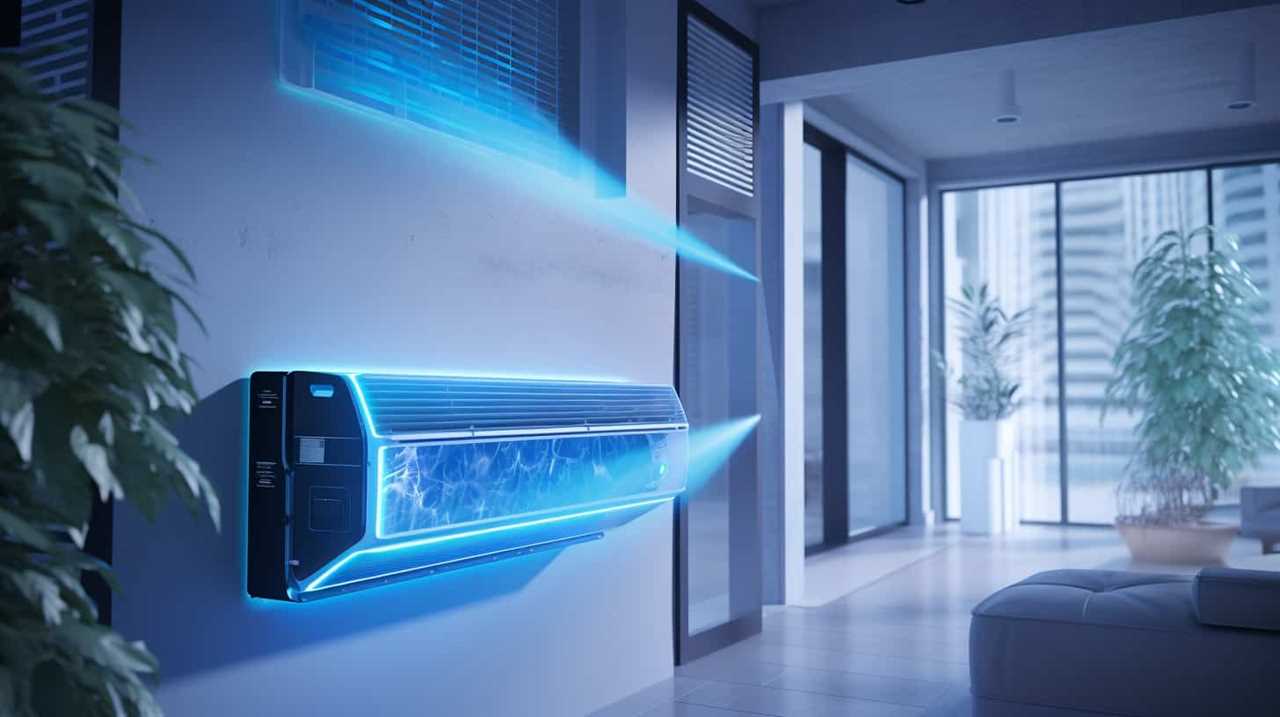
In these heat pumps, thermal energy transfer primarily occurs through conduction and insulation. Conduction refers to the transfer of heat through direct contact between materials, while insulation helps to minimize heat loss or gain by providing a barrier.
Through advancements in heat pump technology, the efficiency and effectiveness of thermal energy transfer have greatly improved. Newer heat pumps utilize advanced refrigerants and innovative designs to optimize heat transfer and reduce energy consumption. These advancements have resulted in higher energy efficiency ratings and increased comfort levels for users.
As we explore the different types of thermal energy transfer in heat pumps, we’ll delve into the specific mechanisms and processes that make them possible.
Exploring the Different Types of Thermal Energy Transfer in Heat Pumps
When it comes to thermal energy transfer in heat pumps, two main types play a significant role: conduction and convection. Conduction refers to the transfer of heat through direct contact between materials, while convection involves the movement of heat through a fluid medium, such as air or water.
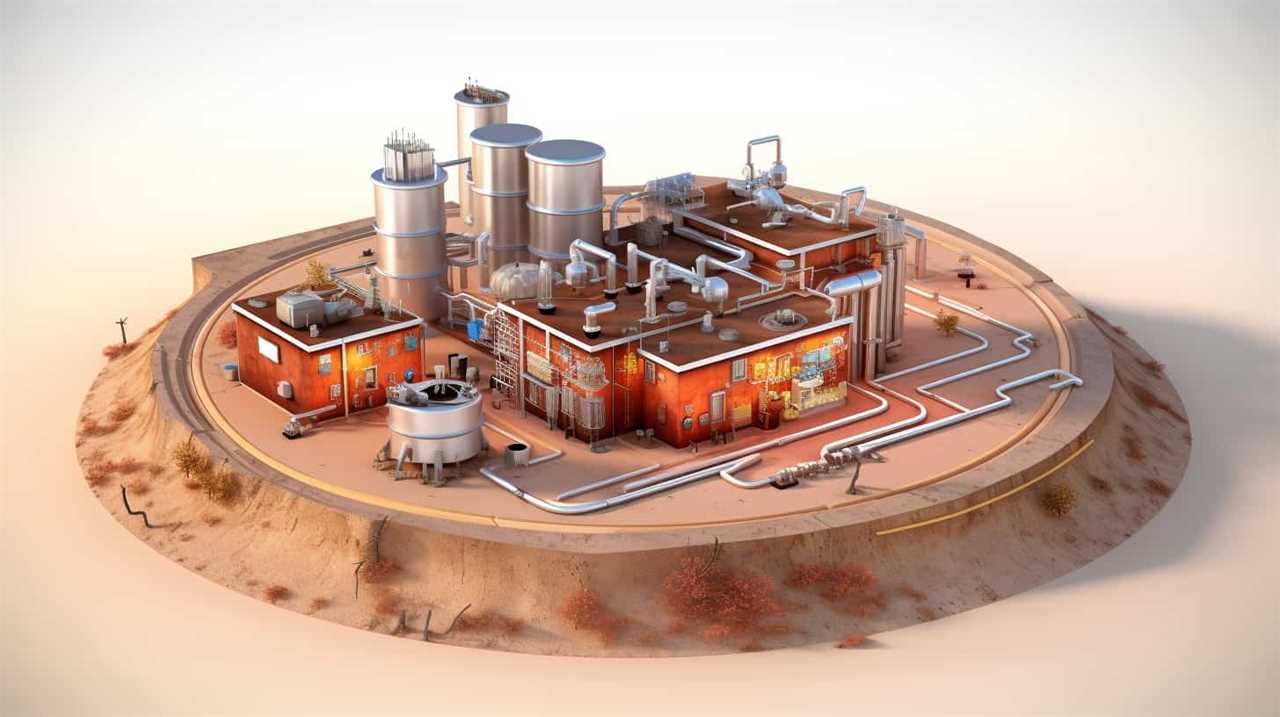
Understanding the distinction between these two mechanisms is crucial for optimizing heat pump performance and efficiency. Additionally, the importance of proper insulation can’t be overstated, as it helps minimize heat loss and maximize the effectiveness of thermal energy transfer in heat pump systems.
Conduction Vs. Convection
In our exploration of thermal energy transfer in heat pumps, we’ll compare conduction and convection to understand the different types of heat transfer. These heat transfer methods play a crucial role in heat pump efficiency and understanding their differences can help us optimize the performance of these systems.
Here are four key points to consider:
-
Conduction: This is the transfer of heat through direct contact between two objects. It occurs when one object is at a higher temperature than the other, causing the heat to flow from the hotter object to the cooler one.

-
Convection: Unlike conduction, convection involves the transfer of heat through the movement of fluids such as air or water. It occurs when the heated fluid rises and is replaced by cooler fluid, creating a continuous cycle of heat transfer.
-
Efficiency: While both conduction and convection contribute to heat transfer in heat pumps, convection is generally more efficient. This is because it allows for a larger surface area for heat exchange, resulting in faster and more effective heat transfer.
-
Optimization: To maximize heat pump efficiency, it’s important to design systems that promote efficient convection, such as using well-designed heat exchangers, optimizing fluid flow, and minimizing heat loss.
Understanding the differences between conduction and convection is essential in designing and operating heat pump systems for optimal performance. However, it’s also crucial to consider the role of insulation in maintaining the efficiency of these systems.
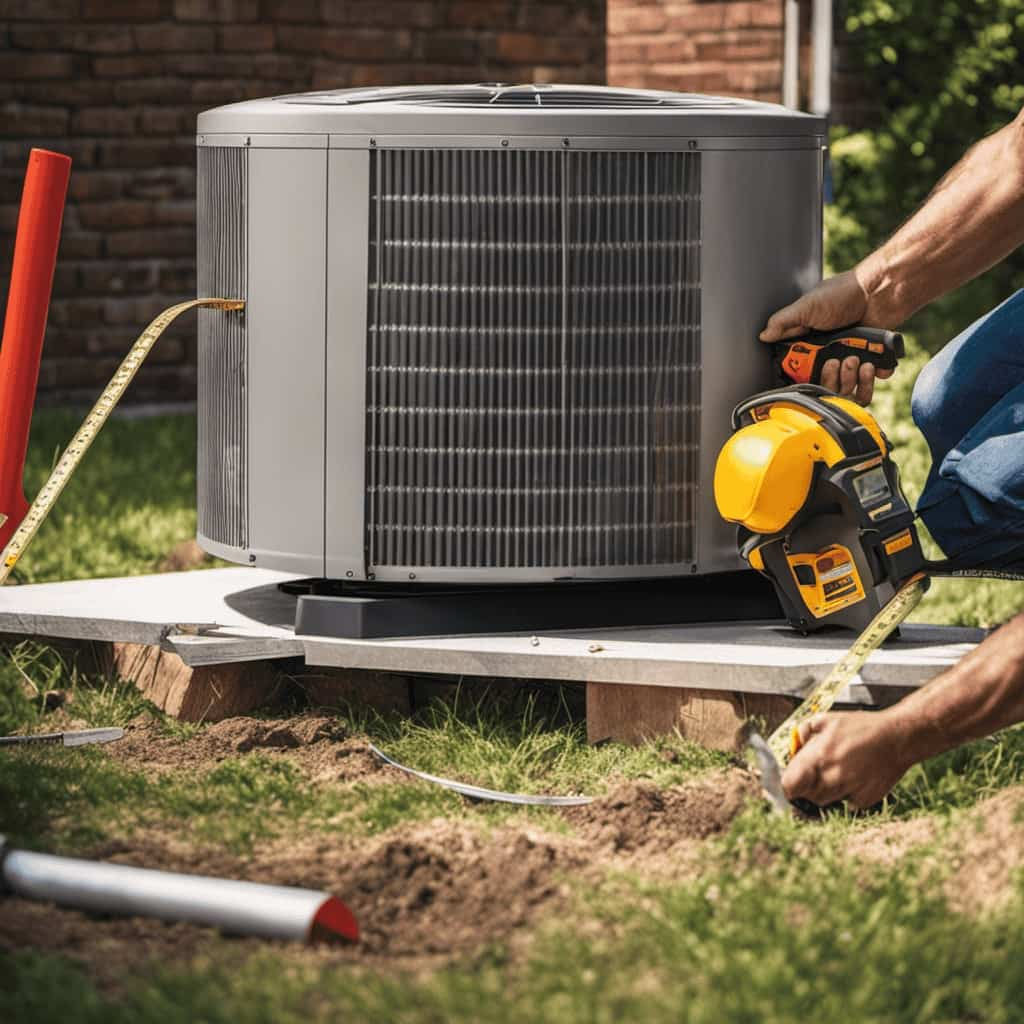
Importance of Insulation
Insulation plays a crucial role in heat pumps as it helps to minimize thermal energy transfer and maintain efficient heat exchange. The choice of insulation materials is essential to ensure optimal energy efficiency. Insulation serves to reduce heat loss or gain by creating a barrier that hinders the flow of heat.
In heat pump systems, insulation is particularly important in preventing heat from escaping during the heating mode and from entering the system during the cooling mode. By minimizing unwanted heat transfer, insulation helps to improve the overall energy efficiency of the heat pump. Different types of insulation materials, such as foam, fiberglass, or cellulose, can be used depending on the specific requirements of the application.
Proper insulation selection and installation are crucial to ensure that heat pumps operate at their maximum efficiency while minimizing energy consumption.
Transition: Now that we understand the importance of insulation in heat pump systems, let’s explore ways to enhance heat transfer performance in these systems.

Enhancing Heat Transfer Performance in Heat Pump Systems
We can improve the heat transfer performance in heat pump systems by optimizing fluid flow. Here are four heat transfer enhancement techniques that can help in improving heat pump efficiency:
-
Increasing the velocity of the fluid: By increasing the fluid velocity, we can enhance convective heat transfer, allowing for better heat exchange between the fluid and the surroundings.
-
Using turbulence promoters: Turbulence promoters, such as baffles or turbulators, can disrupt laminar flow and promote mixing, resulting in improved heat transfer rates.
-
Enhancing heat exchanger surface area: Increasing the surface area of heat exchangers can provide more space for heat transfer, allowing for greater efficiency.

-
Implementing advanced heat transfer fluids: Using fluids with higher thermal conductivity can enhance heat transfer performance, leading to improved heat pump efficiency.
The Impact of Thermal Energy Transfer on Heat Pump Operation
When considering the impact of thermal energy transfer on heat pump operation, we must first examine the overall efficiency of heat pumps.
Efficient heat transfer mechanisms play a crucial role in ensuring optimal performance and reduced energy consumption.
Efficiency of Heat Pumps
One of the key factors affecting the efficiency of heat pumps is the amount of thermal energy transferred during their operation. To ensure optimal energy efficiency and performance, it’s crucial to consider the following:

-
Insulation: Proper insulation of the heat pump system helps minimize heat loss and maximize thermal energy transfer.
-
Heat exchanger design: The design of the heat exchangers plays a significant role in facilitating efficient heat transfer between the refrigerant and the surrounding environment.
-
Refrigerant selection: Choosing the right refrigerant with high heat transfer properties can enhance the overall performance of the heat pump system.
-
System maintenance: Regular maintenance and cleaning of the heat pump system ensure that it operates at peak efficiency by preventing any obstructions or buildup that could hinder thermal energy transfer.

Heat Transfer Mechanisms
To understand the impact of thermal energy transfer on heat pump operation, we need to explore the different heat transfer mechanisms involved. Heat transfer mechanisms play a crucial role in determining the efficiency of a heat pump.
There are three main mechanisms of heat transfer: conduction, convection, and radiation.
Conduction is the transfer of heat through direct contact between two objects or substances. In a heat pump, this occurs when heat is transferred from a warmer source to a cooler one through a conductive medium, such as metal or fluid.
Convection is the transfer of heat through the movement of a fluid, such as air or water. In a heat pump, convection occurs when the fluid absorbs heat from one location and carries it to another.

Radiation is the transfer of heat through electromagnetic waves. In a heat pump, radiation occurs when heat is emitted or absorbed by objects without direct contact.
Understanding these heat transfer mechanisms is crucial for optimizing heat pump efficiency. By maximizing the effectiveness of each mechanism, we can ensure that thermal energy transfer is optimized, resulting in improved heat pump performance and energy savings.
Impact on Energy Consumption
Our understanding of thermal energy transfer’s impact on heat pump operation is essential to optimize energy consumption. By minimizing energy consumption and increasing energy efficiency, we can reduce our environmental footprint and lower energy costs.
Here are four key ways in which thermal energy transfer affects energy consumption in heat pumps:

-
Heat loss: Inefficient insulation and poor sealing can lead to heat loss during thermal energy transfer, resulting in increased energy consumption. Proper insulation and sealing techniques can help minimize this loss.
-
Heat gain: In warm climates, heat gain can occur during thermal energy transfer, causing the heat pump to work harder and consume more energy. Implementing shading techniques and using reflective materials can help reduce heat gain.
-
Temperature differences: Large temperature differences between the heat source and the desired indoor temperature can increase energy consumption. Maintaining a smaller temperature differential can optimize energy efficiency.
-
System maintenance: Regular maintenance of the heat pump system, including cleaning filters and checking for leaks, is crucial to ensure optimal thermal energy transfer and minimize energy consumption.

Thermal Energy Transfer and the Efficiency of Heat Pump Components
The efficiency of heat pump components relies heavily on the thermal energy transfer process. Maximizing efficiency in heat pump systems requires the effective transfer of thermal energy between different components. This ensures that the heat pump operates at peak performance, saving energy and reducing costs. To achieve this, various heat transfer techniques are employed in different components of the heat pump system.
One of the key components in a heat pump system is the evaporator. Its primary function is to absorb heat from the surrounding environment and transfer it to the refrigerant. This transfer of thermal energy is facilitated by the use of a refrigerant with a low boiling point and a large surface area for heat exchange. Another important component is the condenser, which releases the absorbed heat to the desired space. The condenser utilizes heat transfer techniques such as convection and radiation to efficiently transfer the thermal energy.
To better understand the efficiency of heat pump components and their thermal energy transfer capabilities, let’s take a look at the following table:
| Heat Pump Component | Heat Transfer Technique |
|---|---|
| Evaporator | Heat Absorption |
| Condenser | Heat Release |
| Compressor | Heat Compression |
| Expansion Valve | Heat Expansion |
Optimizing Thermal Energy Transfer for Improved Heat Pump Performance
To optimize thermal energy transfer and improve heat pump performance, we must focus on maximizing efficiency and minimizing heat loss. Here are four key ways to optimize heat transfer and improve heat pump efficiency:
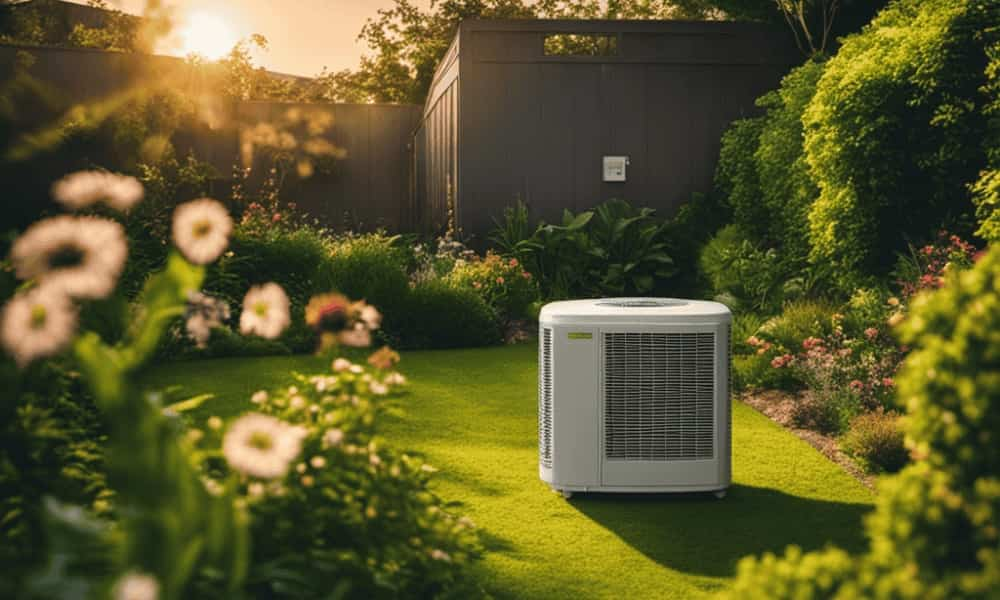
-
Insulation: Proper insulation around pipes, ducts, and components reduces heat loss and improves overall system efficiency.
-
Sizing: Ensuring the heat pump is properly sized for the space being heated or cooled is crucial. Oversized or undersized heat pumps can result in inefficient operation and increased energy consumption.
-
Coils and Fins: Regular maintenance and cleaning of coils and fins help optimize heat transfer by ensuring proper airflow and heat exchange.
-
Refrigerant Charge: Correct refrigerant charge is essential for efficient heat pump operation. Improper refrigerant levels can lead to reduced heat transfer and increased energy consumption.

The Future of Thermal Energy Transfer in Heat Pump Technology
We are excited about the future advancements in thermal energy transfer that will revolutionize heat pump technology.
The field of heat pumps is constantly evolving, and there are several promising technological innovations on the horizon.
One area of focus is improving the efficiency of thermal energy transfer within heat pumps. Researchers and engineers are exploring new materials and designs that will enhance heat transfer rates and reduce energy losses.
Additionally, advancements in control systems and algorithms are being developed to optimize the operation of heat pumps and further improve their performance.

These future advancements in thermal energy transfer won’t only increase the efficiency of heat pumps but also make them more reliable and cost-effective for consumers.
As we continue to invest in research and development, we’re confident that these technological innovations will shape the future of heat pump technology.
Frequently Asked Questions
How Does Thermal Energy Transfer Affect the Overall Efficiency of a Heat Pump System?
Thermal energy transfer greatly affects the overall efficiency of a heat pump system. The insulation’s impact is crucial. By minimizing heat loss or gain, the system can operate at peak performance, saving energy and serving others effectively.
What Are the Main Factors That Can Influence Thermal Energy Transfer in Heat Pumps?
Factors that influence thermal energy transfer in heat pumps include the temperature difference between the heat source and sink, the type and condition of the working fluid, and the efficiency of the heat exchanger.
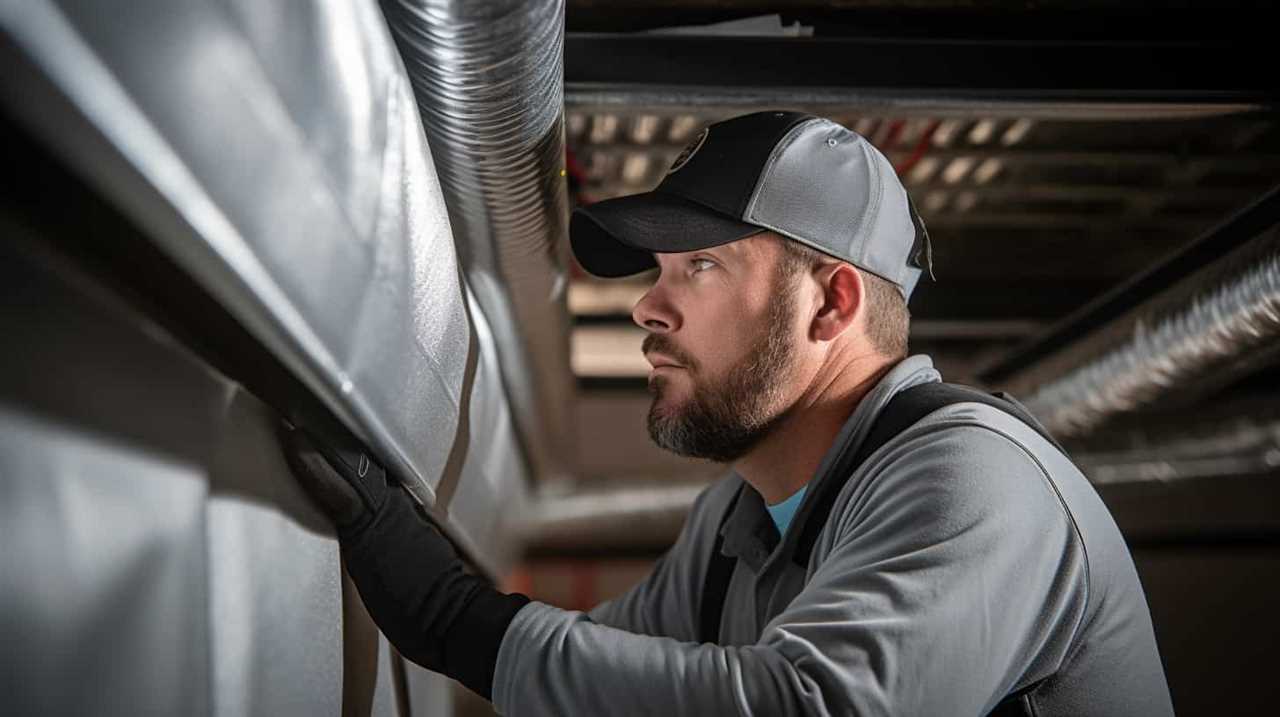
Can You Explain How Thermal Energy Transfer Occurs in Refrigerant-Based Heat Pumps?
Thermal energy transfer in refrigerant-based heat pumps involves exploring the role of phase change and understanding the impact of refrigerant flow rate on efficiency. It is a technical process that requires precise analysis to serve others effectively.
Are There Different Types of Thermal Energy Transfer in Heat Pumps? if So, What Are They?
There are indeed different types of thermal energy transfer in heat pumps, each with its own significance in overall performance. Let’s explore these types and how they contribute to the efficiency of heat pump systems.
What Strategies or Techniques Can Be Used to Enhance Heat Transfer Performance in Heat Pump Systems?
To enhance heat transfer performance and improve system efficiency in heat pump systems, various strategies and techniques can be used. These include optimizing the design of heat exchangers, implementing advanced control algorithms, and utilizing high-efficiency refrigerants.
Conclusion
In conclusion, thermal energy transfer plays a crucial role in the efficiency and performance of heat pumps. By understanding the basics of heat transfer and optimizing its process, we can enhance the overall efficiency and effectiveness of heat pump technology.

Factors such as heat pump components and the occurrence of heat transfer in refrigerant-based systems greatly impact the operation and effectiveness of heat pumps.
As we continue to study and improve thermal energy transfer, we can look forward to even more advanced heat pump technology in the future.
Thermal Energy Transfer
Understanding Thermal Energy Transfer in Refrigerant Heat Pumps

In this article, we explore the intricate processes involved in transferring heat energy in refrigerant heat pumps. By understanding the basics of this operation, we can boost the performance of these units and provide better service to our customers.
Through analyzing real-life case studies and hypothetical scenarios, we delve into the different types of heat transfer involved and the factors that affect efficiency.
Join us as we uncover the latest innovations in thermal energy transfer technology, ensuring optimal operation and customer satisfaction.
Key Takeaways
- Conduction is the transfer of heat through direct contact between objects of different temperatures.
- Convection involves the transfer of heat through the movement of a fluid.
- Proper refrigerant selection is crucial for efficient heat transfer and reduced environmental impact.
- Transitioning to alternative refrigerants with lower GWP and ODP values is important for reducing emissions.
The Basics of Thermal Energy Transfer in Refrigerant Heat Pumps
We will now explore the three fundamental processes involved in thermal energy transfer in refrigerant heat pumps. Understanding the basics of heat transfer and the principles of thermal energy transfer is essential in comprehending the inner workings of these systems.

The first process involved in thermal energy transfer is conduction. This occurs when heat is transferred through direct contact between two objects of different temperatures. The heat flows from the hotter object to the cooler one until equilibrium is reached.
The second process is convection. This involves the transfer of heat through the movement of a fluid, such as air or liquid. As the fluid absorbs heat from a source, it becomes less dense and rises, carrying the heat with it. The cooler fluid then takes its place, creating a continuous cycle of heat transfer.
Lastly, we have radiation. This process occurs when heat is transferred through electromagnetic waves. Unlike conduction and convection, radiation doesn’t require a medium to transfer heat. Instead, it can occur in a vacuum, making it useful in space applications.
Understanding these fundamental processes is crucial in designing and operating efficient refrigerant heat pumps. By optimizing these processes, we can ensure maximum thermal energy transfer and provide effective services to those in need.

Understanding the Role of Refrigerants in Heat Pump Systems
Refrigerants play a crucial role in the operation of heat pump systems, as they’re responsible for transferring thermal energy.
Understanding the importance of selecting the right refrigerant is essential for optimizing heat pump efficiency.
Additionally, considering the environmental impact of refrigerants is crucial in order to minimize greenhouse gas emissions and ensure sustainable heating and cooling solutions.
Importance of Refrigerants
One of the key factors in heat pump systems is the choice of refrigerant. The selection of the appropriate refrigerant is crucial as it directly affects the overall performance and efficiency of the heat pump system. The properties of the refrigerant play a vital role in determining its suitability for a specific application. These properties include thermodynamic properties such as boiling point, specific heat capacity, and pressure-temperature relationship.

Additionally, other factors like environmental impact, safety, and cost must also be considered during refrigerant selection. For instance, refrigerants with low global warming potential (GWP) and ozone depletion potential (ODP) are preferred due to their reduced environmental impact.
Moreover, safety concerns such as flammability and toxicity must be taken into account to ensure the well-being of both users and the environment.
Heat Pump Efficiency
To maximize heat pump efficiency, it’s important to understand the role of refrigerants in the system. Refrigerants play a crucial role in the heat transfer process within a heat pump. Here are some key points to consider:
-
Proper refrigerant selection: Choosing the right refrigerant for your heat pump is essential. Opt for refrigerants with higher thermodynamic properties and lower global warming potential (GWP). This ensures efficient heat transfer and reduces environmental impact.

-
Regular heat pump maintenance: Regular maintenance is vital for optimizing heat pump efficiency. Schedule routine inspections to check for refrigerant leaks, clean the coils, and ensure proper airflow. This helps maintain the system’s performance and prevents energy wastage.
Environmental Impact of Refrigerants
How do different refrigerants affect the environment and what is their role in heat pump systems? The environmental impact of refrigerants is a critical consideration in heat pump systems. Refrigerants are substances used in heat pumps to transfer thermal energy. While they are essential for the functioning of heat pumps, certain refrigerants can have negative effects on the environment, particularly in terms of global warming potential (GWP) and ozone depletion potential (ODP). To mitigate these impacts, there is a growing focus on reducing emissions and transitioning to alternative refrigerants with lower GWP and ODP values. These alternative refrigerants, such as hydrofluorocarbons (HFCs), hydrochlorofluorocarbons (HCFCs), and natural refrigerants like ammonia and carbon dioxide, offer environmentally friendly options for heat pump systems. The table below provides a visual representation of the characteristics and environmental impact of different refrigerants.
| Refrigerant | GWP | ODP |
|---|---|---|
| Hydrofluorocarbons | High | None |
| Hydrochlorofluorocarbons | Moderate | Low |
| Ammonia | Low | None |
| Carbon Dioxide | Negligible | None |
Exploring the Different Types of Heat Transfer in Refrigerant-Based Heat Pumps
When it comes to heat transfer in refrigerant-based heat pumps, two main types are conduction and convection.
Conduction involves the transfer of thermal energy through direct contact between materials, while convection involves the movement of heat through the circulation of a fluid, such as refrigerant.

Understanding these types of heat transfer is crucial for optimizing heat pump efficiency and performance.
Additionally, the role of the refrigerant itself plays a critical role in facilitating the transfer of thermal energy within the heat pump system.
Conduction Vs. Convection
Exploring the different types of heat transfer in refrigerant-based heat pumps, we compare conduction and convection. These two mechanisms play a crucial role in the thermal energy transfer within the system.
Here is a breakdown of the differences between conduction and convection:
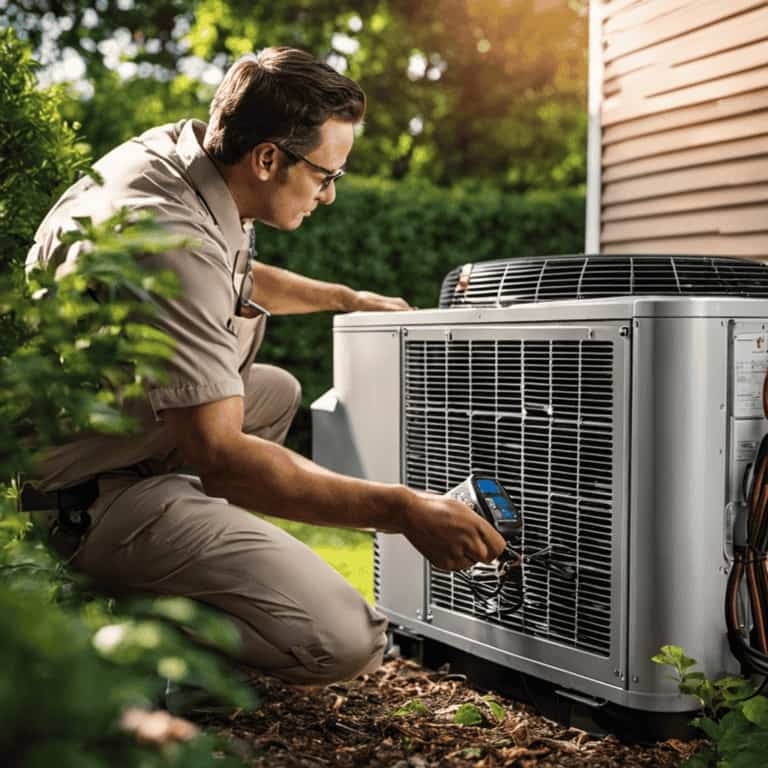
-
Conduction:
-
Involves the transfer of heat through direct contact between two objects.
-
Relies on the physical properties of the materials involved, such as conductivity.
-
Occurs in solids and liquids, but not in gases.

-
Can be enhanced by increasing the surface area or using materials with higher conductivity.
-
Convection:
-
Involves the transfer of heat through the movement of a fluid, either liquid or gas.
-
Relies on the natural or forced movement of the fluid to carry heat away.

-
Occurs in all three states of matter.
-
Can be enhanced by increasing the fluid flow rate or using devices like fans or pumps.
Understanding the differences between conduction and convection allows for optimizing heat transfer efficiency in refrigerant-based heat pumps, ensuring effective cooling or heating for the desired applications.
Heat Pump Efficiency
To maximize efficiency, we must consider the different types of heat transfer used in refrigerant-based heat pumps. Heat pump efficiency is crucial for achieving optimal performance and energy savings. There are several factors that contribute to the efficiency of a heat pump, including the type of heat transfer employed.
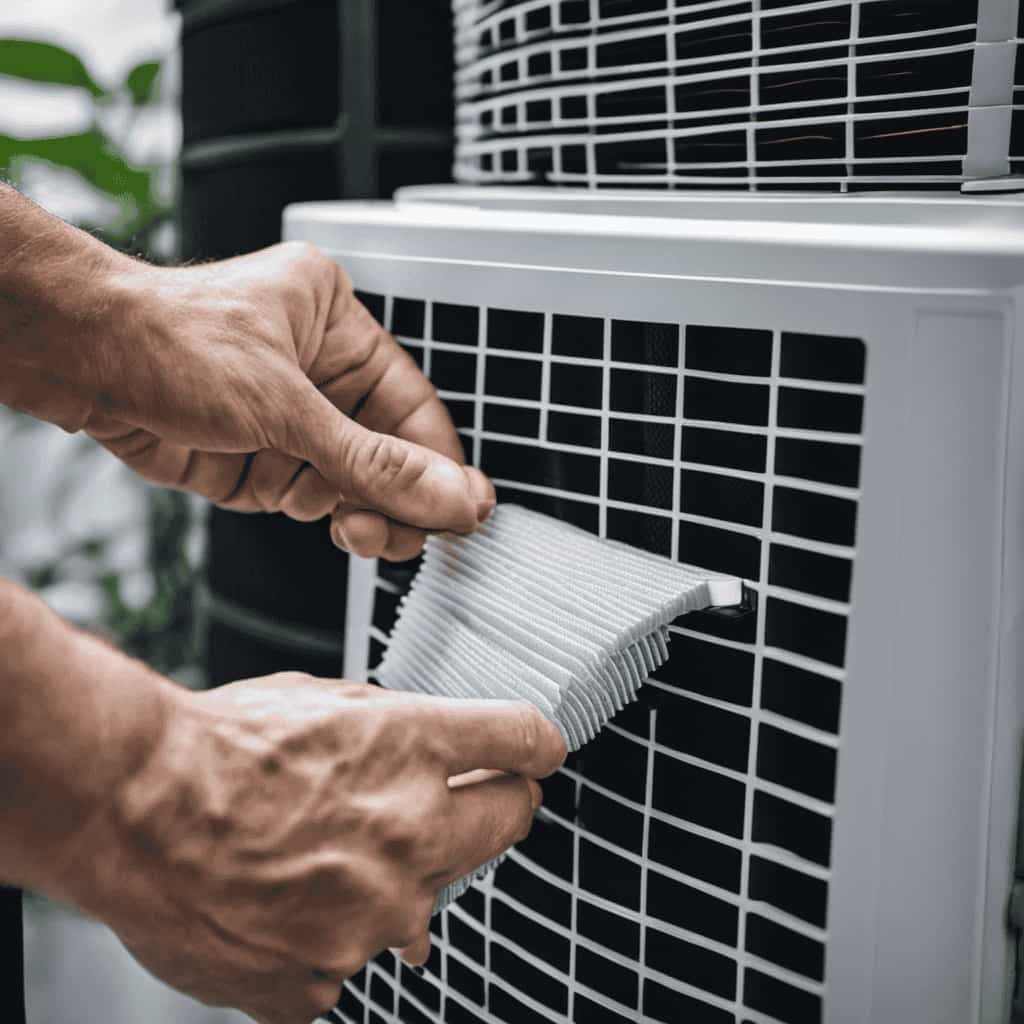
In refrigerant-based heat pumps, the primary types of heat transfer are conduction, convection, and radiation. Conduction occurs when heat is transferred through direct contact between materials, such as when the refrigerant absorbs heat from the surrounding air or water. Convection involves the transfer of heat through the movement of fluid, such as the circulation of refrigerant within the heat pump system. Radiation is the transfer of heat through electromagnetic waves, which can occur when the refrigerant releases heat to the environment.
Role of Refrigerant
One of the key roles of refrigerant in heat pumps is facilitating the three main types of heat transfer: conduction, convection, and radiation. The properties of the refrigerant play a crucial role in determining its effectiveness in transferring thermal energy.
When selecting a refrigerant for a heat pump, several factors must be considered. These include the refrigerant’s thermal conductivity, specific heat capacity, and viscosity. Each of these properties affects the heat transfer process and ultimately the efficiency of the heat pump.
Additionally, the refrigerant’s chemical stability and compatibility with the heat pump components are important factors to consider. Choosing the right refrigerant is essential for optimizing heat transfer and ensuring the overall performance and longevity of the heat pump system.

The Importance of Efficient Thermal Energy Transfer in Heat Pump Operation
Since efficient thermal energy transfer is crucial for heat pump operation, we must understand its importance.
One key aspect to consider is the role of insulation in maximizing energy efficiency. Proper insulation helps to minimize heat loss during the transfer process, ensuring that the heat pump operates at optimal efficiency. Insulation materials with high thermal resistance, such as fiberglass or foam, can effectively prevent heat transfer through walls and pipes.
Additionally, optimizing heat exchangers is essential for efficient thermal energy transfer in heat pump systems. Heat exchangers play a vital role in transferring heat between the refrigerant and the surrounding environment. By maximizing the surface area available for heat transfer and minimizing thermal resistances, heat exchangers can enhance the overall efficiency of the heat pump system.
Therefore, understanding the importance of insulation and optimizing heat exchangers is crucial for achieving efficient thermal energy transfer in heat pump operation.

Factors Affecting Thermal Energy Transfer Efficiency in Refrigerant Heat Pumps
Two factors significantly affect the thermal energy transfer efficiency in refrigerant heat pumps: the temperature difference between the refrigerant and the environment, and the effectiveness of the heat exchanger.
-
Temperature difference: The greater the temperature difference between the refrigerant and the environment, the more efficient the heat transfer. This is because a larger temperature gradient allows for faster and more effective heat exchange.
-
Heat exchanger effectiveness: The design and condition of the heat exchanger also play a crucial role in optimizing heat pump performance. Factors such as the surface area, material conductivity, and cleanliness impact the efficiency of heat transfer. A well-designed and maintained heat exchanger can minimize energy losses and maximize heat transfer efficiency.
By understanding and optimizing these factors affecting heat transfer efficiency, we can improve the performance of refrigerant heat pumps.

In the subsequent section, we’ll explore the innovations and advances in thermal energy transfer technology for heat pumps, further enhancing their efficiency and effectiveness.
Innovations and Advances in Thermal Energy Transfer Technology for Heat Pumps
We have observed significant innovations and advances in thermal energy transfer technology for heat pumps. These advancements have primarily focused on improving the efficiency and effectiveness of heat exchangers and exploring new refrigerant alternatives.
In terms of heat exchanger technology, there have been notable advancements in both design and materials. Engineers have developed more efficient heat exchanger geometries, such as microchannel and compact designs, which enhance heat transfer rates and reduce pressure losses. Additionally, the use of advanced materials, such as nanostructured surfaces and coatings, has contributed to improved heat transfer performance by enhancing heat transfer coefficients and reducing fouling.
Furthermore, the search for environmentally friendly refrigerant alternatives has led to the development of new working fluids with lower global warming potential and ozone depletion potential. These alternatives include hydrofluoroolefins (HFOs) and hydrofluorocarbons (HFCs), which offer improved thermodynamic properties and lower environmental impact compared to traditional refrigerants like chlorofluorocarbons (CFCs) and hydrochlorofluorocarbons (HCFCs).

Frequently Asked Questions
What Are Some Common Problems That Can Affect the Efficiency of Thermal Energy Transfer in Refrigerant Heat Pumps?
Potential causes of reduced thermal energy transfer in refrigerant heat pumps include low refrigerant levels, dirty coils, and faulty components. Troubleshooting techniques involve checking and adjusting refrigerant levels, cleaning coils, and repairing or replacing faulty parts for optimal efficiency.
How Does the Size and Design of a Heat Pump System Impact Its Thermal Energy Transfer Efficiency?
The size and design of a heat pump system greatly impact its thermal energy transfer efficiency. Proper insulation is crucial to minimize heat loss, while advanced compressor technology improves performance and maximizes energy transfer.
Can the Efficiency of Thermal Energy Transfer in Refrigerant Heat Pumps Be Improved Through Regular Maintenance and Cleaning?
Regular maintenance and cleaning of refrigerant heat pumps can significantly improve the efficiency of thermal energy transfer. Environmental factors such as dust and debris accumulation can hinder heat exchange, making maintenance crucial for optimal performance.
Are There Any Regulations or Standards in Place to Ensure the Efficiency of Thermal Energy Transfer in Heat Pump Systems?
There are regulations and standards in place to ensure the efficiency of thermal energy transfer in heat pump systems. These guidelines help maintain optimal performance and ensure that the systems meet industry standards for energy efficiency.

What Are Some Potential Future Developments or Advancements in Thermal Energy Transfer Technology for Heat Pumps That Could Further Enhance Efficiency?
Advancements in refrigerant technology and novel materials for heat exchangers hold potential for enhancing the efficiency of thermal energy transfer in heat pumps. These developments can lead to greater energy savings and improved performance.
Conclusion
In conclusion, understanding thermal energy transfer in refrigerant heat pumps is crucial for optimizing their efficiency. By exploring the different types of heat transfer and considering factors that affect thermal energy transfer efficiency, we can enhance the performance of heat pump systems.
One interesting statistic is that recent innovations in thermal energy transfer technology have resulted in a 20% increase in the overall efficiency of refrigerant heat pumps, leading to significant energy savings and environmental benefits.
Thermal Energy Transfer
Understanding Geothermal Heat Pumps: Thermal Energy Transfer Principles
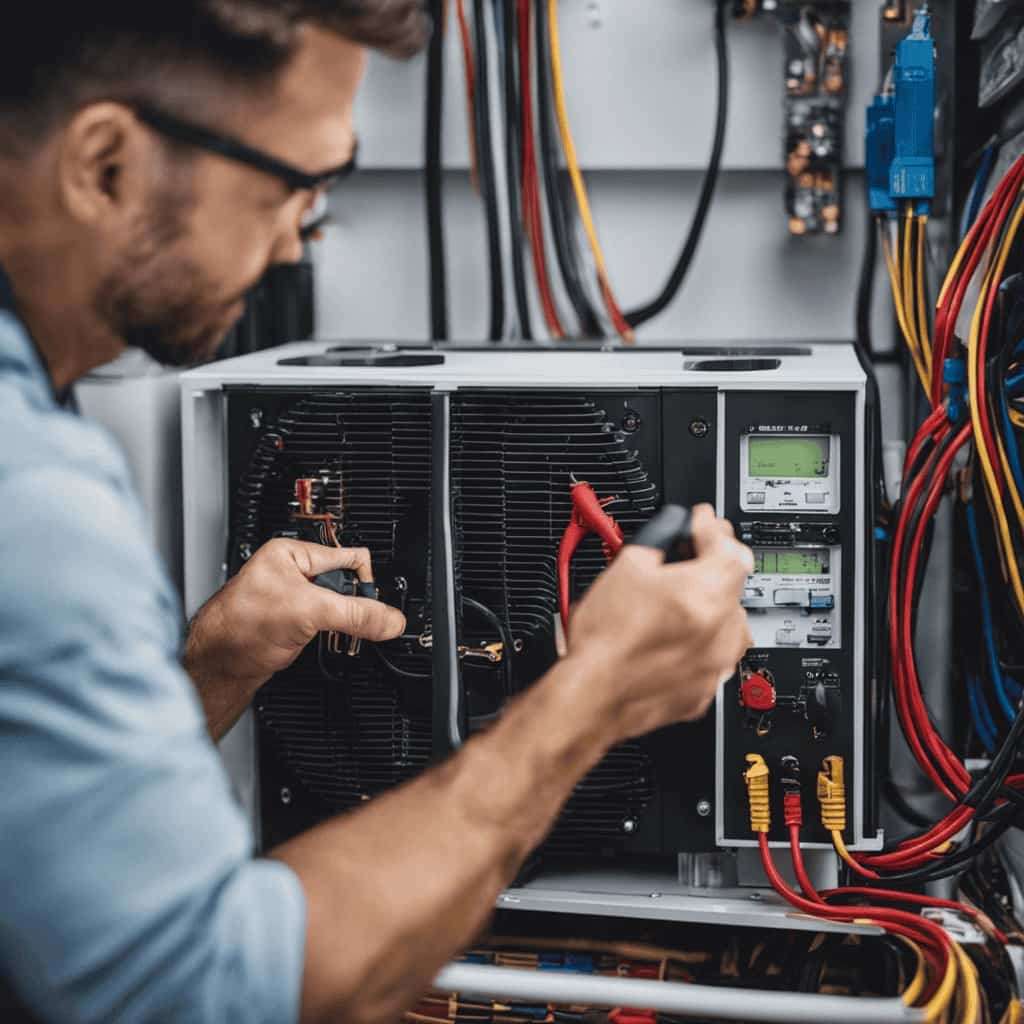
Tired of the freezing cold during winter? Look no further! This article will delve into the fascinating world of geothermal heat pumps and the basics of transferring heat energy.
We’ll break down the basics, explore different modes of heat transfer, and delve into the inner workings of these efficient systems.
Get ready to understand and optimize the thermal energy transfer in geothermal heat pumps – it’s time to keep warm and cozy!
Key Takeaways
- Thermal conductivity plays a crucial role in heat transfer in geothermal heat pumps.
- Geothermal heat pumps utilize the constant temperature of the earth to extract thermal energy.
- Conduction, convection, and radiation are the main modes of heat transfer in geothermal heat pumps.
- Maximizing heat transfer efficiency is important for optimal performance, energy savings, and system lifespan.
Basics of Thermal Energy Transfer
Now that we’ve covered the fundamentals of geothermal heat pumps, let’s delve into the basics of thermal energy transfer.

Understanding how heat is transferred is crucial in the design and operation of geothermal systems. One important concept in thermal energy transfer is thermal conductivity measurement.
Thermal conductivity refers to the ability of a material to conduct heat. It’s a property that determines how easily heat can flow through a substance.
To quantify thermal conductivity, we use heat transfer equations that take into account factors such as temperature gradients and material properties. These equations help us calculate the rate of heat transfer and determine the efficiency of geothermal heat pumps.
Importance of Thermal Energy Transfer in Geothermal Heat Pumps
To fully grasp the significance of thermal energy transfer in geothermal heat pumps, we must understand how it impacts the efficiency and performance of the system. The thermodynamics of geothermal systems play a crucial role in achieving energy savings in heat transfer. By effectively transferring thermal energy from the ground to the heat pump, geothermal systems can provide efficient heating and cooling for residential and commercial buildings.

This process involves the extraction of heat from the ground through a geothermal loop system, which then transfers this heat to the heat pump for distribution throughout the building. By utilizing the constant temperature of the earth, geothermal heat pumps can achieve significant energy savings compared to traditional heating and cooling systems.
Understanding the importance of thermal energy transfer in geothermal heat pumps is key to maximizing their efficiency and performance.
In the subsequent section, we’ll explore the different heat transfer modes in geothermal heat pumps and how they contribute to the overall functionality of the system.
Heat Transfer Modes in Geothermal Heat Pumps
When it comes to geothermal heat pumps, understanding the different modes of heat transfer is crucial.

These modes include conduction, convection, and radiation, and they play a vital role in the efficiency of heat transfer within the system.
Modes of Heat Transfer
We use three main modes of heat transfer in geothermal heat pumps to efficiently transfer thermal energy. Understanding these modes is crucial in designing and operating effective geothermal systems.
Here are the three modes of heat transfer in geothermal heat pumps:
-
Conduction: This mode of heat transfer occurs when thermal energy moves through solid materials. In geothermal systems, heat is conducted from the earth’s surface to the underground heat exchanger, allowing for the transfer of thermal energy.

-
Convection: Convection involves the transfer of heat through fluids or gases. In geothermal heat pumps, convection occurs as the fluid circulates through the heat exchanger, absorbing or releasing heat depending on the desired heating or cooling effect.
-
Radiation: Radiation refers to the transfer of heat through electromagnetic waves. In geothermal systems, radiation occurs when heat is emitted or absorbed by the earth’s surface, contributing to the overall thermal energy transfer.
Efficiency of Heat Transfer
Our goal is to maximize the efficiency of heat transfer in geothermal heat pumps by optimizing the modes of conduction, convection, and radiation. Heat transfer optimization is crucial for achieving energy efficiency in geothermal heat pumps. By understanding and enhancing these heat transfer modes, we can ensure that the system operates at its highest potential.
To illustrate the different modes of heat transfer and their importance in geothermal heat pumps, we provide the following table:

| Heat Transfer Mode | Description |
|---|---|
| Conduction | The transfer of heat through direct contact between solids or stationary fluids. |
| Convection | The transfer of heat through the movement of fluids, either natural or forced. |
| Radiation | The transfer of heat through electromagnetic waves, without the need for a medium. |
Importance of Heat Transfer
Optimizing heat transfer modes is essential in geothermal heat pumps to ensure efficient thermal energy transfer. By understanding the different heat transfer mechanisms and how to optimize them, we can maximize the performance of geothermal heat pumps and provide effective heating and cooling solutions.
Here are four key reasons why optimizing thermal energy transfer is crucial in geothermal heat pumps:
-
Increased energy efficiency: By optimizing heat transfer modes, we can minimize energy wastage and improve the overall efficiency of the heat pump system. This leads to reduced energy consumption and lower operating costs.
-
Enhanced system performance: Optimizing thermal energy transfer ensures that the heat pump operates at its maximum potential, delivering consistent and comfortable heating or cooling throughout the year.

-
Longer system lifespan: Proper heat transfer optimization minimizes the strain on the components of the heat pump system, leading to a longer lifespan and reduced maintenance requirements.
-
Environmental benefits: By maximizing the efficiency of geothermal heat pumps, we can reduce greenhouse gas emissions and contribute to a more sustainable and eco-friendly future.
Understanding Conduction in Geothermal Heat Pumps
Conduction is one of the heat transfer mechanisms utilized in geothermal heat pumps. It involves the transfer of thermal energy through direct contact between materials. The conductivity of materials plays a crucial role in determining the efficiency of energy transfer.
Understanding the principles of conduction enables us to design and optimize geothermal heat pump systems for efficient heat exchange and energy savings.

Heat Transfer Mechanisms
When discussing heat transfer mechanisms in geothermal heat pumps, we need to understand conduction. Conduction is the process by which heat is transferred through direct contact between two objects with different temperatures. In the context of geothermal heat pumps, conduction plays a crucial role in extracting and transferring thermal energy from the ground to the heat pump system.
Here are four key principles of conduction in geothermal heat pumps:
-
Thermal conductivity: Different materials have different abilities to conduct heat. Understanding the thermal conductivity of the ground and the materials used in the heat pump system is essential for efficient heat transfer.
-
Ground loop design: The design of the ground loop system, which consists of pipes buried underground, affects the conduction process. Proper spacing, depth, and configuration of the pipes optimize heat transfer.

-
Heat exchanger: The heat exchanger within the heat pump facilitates the transfer of heat between the refrigerant and the ground loop system, maximizing conduction efficiency.
-
Insulation: Insulating materials are used to minimize heat loss during the conduction process, ensuring that the transferred thermal energy is effectively utilized by the heat pump system.
Understanding these principles of conduction in geothermal heat pumps is crucial for designing and operating efficient and effective systems that serve the needs of consumers.
Conductivity of Materials
How does the conductivity of materials impact the conduction process in geothermal heat pumps?

The conductivity of materials plays a crucial role in the efficiency of heat transfer in geothermal heat pumps. Thermal conductivity refers to the ability of a material to conduct heat.
In the context of geothermal heat pumps, materials with higher thermal conductivity allow for more efficient heat transfer between the heat source and the heat pump system. This means that materials with higher thermal conductivity will facilitate a faster and more effective exchange of heat energy, resulting in improved performance and energy efficiency of the geothermal heat pump system.
Heat transfer coefficients, which are influenced by the thermal conductivity of materials, determine the rate at which heat is transferred. By selecting materials with optimal thermal conductivity, geothermal heat pump systems can maximize their heat transfer efficiency and provide effective heating and cooling solutions for their users.
Efficient Energy Transfer
To achieve efficient energy transfer in geothermal heat pumps, we must understand the principles of thermal conduction. In this process, heat is transferred through solid materials by the movement of atoms and molecules.

Here are four important factors to consider for efficient energy transfer in geothermal heat pumps:
-
Insulation: Proper insulation helps to minimize heat loss during the transfer process, ensuring more efficient use of energy and reducing the need for additional heating or cooling.
-
Heat exchangers: These devices facilitate the transfer of heat between the geothermal system and the indoor space. They optimize energy conservation and ensure that the renewable energy source is utilized effectively.
-
Sizing: Properly sizing the geothermal heat pump system ensures that it meets the specific heating and cooling demands of the building, maximizing energy efficiency and minimizing wasted energy.
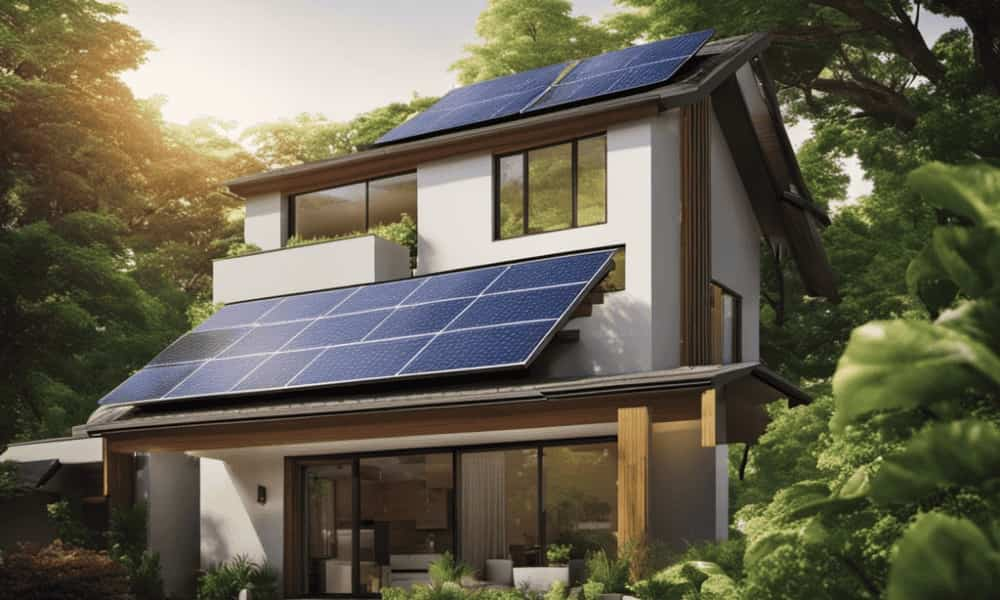
-
Regular maintenance: Regular maintenance and inspection of the geothermal heat pump system are essential for efficient energy transfer. This includes cleaning or replacing filters, checking refrigerant levels, and inspecting the heat exchanger for any potential issues.
Exploring Convection in Geothermal Heat Pumps
We can gain a better understanding of convection in geothermal heat pumps by examining the movement of thermal energy through the system. Convection plays a crucial role in the efficient transfer of heat in geothermal systems. By exploring fluid dynamics and heat transfer coefficients, we can optimize the convection process to enhance the overall performance of the heat pump.
Fluid dynamics involves the study of how fluids, such as water or refrigerant, move and interact within the system. Heat transfer coefficients, on the other hand, quantify the rate at which heat is transferred between the fluid and the surrounding surfaces. By manipulating these factors, we can ensure that the heat pump effectively extracts thermal energy from the ground and distributes it throughout the building. Understanding convection is essential for maximizing the energy efficiency and comfort provided by geothermal heat pumps.
Now, let’s delve into the role of radiant heat transfer in geothermal systems.
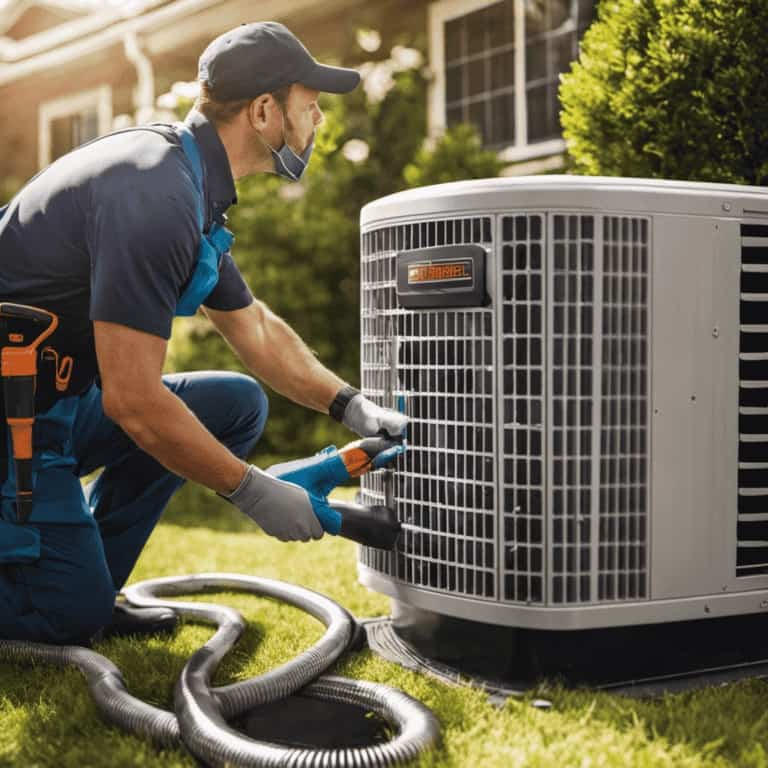
The Role of Radiant Heat Transfer in Geothermal Systems
Radiant heat transfer plays a crucial role in geothermal systems, contributing to both efficiency and thermal comfort in buildings.
By utilizing radiant heat, geothermal systems can distribute warmth evenly throughout a space, reducing the need for forced air heating and improving energy efficiency.
Additionally, radiant heat transfer provides a more comfortable indoor environment by eliminating drafts and maintaining consistent temperatures.
Efficiency of Radiant Heat
One important factor to consider when evaluating the efficiency of radiant heat in geothermal systems is the percentage of thermal energy that’s effectively transferred. In order to understand the efficiency of radiant heat, it’s crucial to recognize the benefits it offers and the proper installation techniques.

Here are four key points to consider:
-
Enhanced Comfort: Radiant heat provides a more comfortable environment compared to traditional forced-air heating systems. It evenly distributes heat throughout a space, eliminating cold spots and drafts.
-
Energy Efficiency: Radiant heat is highly energy efficient, as it operates at lower water temperatures compared to other heating methods. This reduces energy consumption and lowers utility bills.
-
Reduced Allergens: Radiant heat doesn’t require air ducts, which often harbor dust, allergens, and pollutants. This improves indoor air quality and is particularly beneficial for individuals with allergies or respiratory issues.

-
Longevity: Radiant heat systems have a longer lifespan compared to other heating systems, reducing the need for frequent replacements and repairs.
As we delve into the topic of thermal comfort in buildings, it’s important to understand how radiant heat plays a significant role in achieving optimal comfort levels.
Thermal Comfort in Buildings
How does radiant heat transfer contribute to thermal comfort in buildings with geothermal systems? Radiant heat transfer plays a crucial role in maintaining thermal comfort in buildings with geothermal systems. Unlike traditional heating systems that rely on forced air, geothermal systems use radiant heat transfer to distribute warmth evenly throughout a space. This method ensures that occupants experience consistent and comfortable temperatures. Additionally, radiant heat transfer eliminates the need for noisy fans or ductwork, providing a quieter and more peaceful environment. Geothermal systems also have the advantage of passive cooling, which utilizes the earth’s stable temperature to provide natural cooling during hot weather. This reduces the reliance on energy-intensive air conditioning systems, resulting in lower energy costs and a more sustainable approach to building comfort.
| Pros | Cons |
|---|---|
| Consistent and comfortable temperatures | Initial installation cost |
| Quieter and more peaceful environment | Requires professional installation |
| Lower energy costs | Requires proper building insulation |
| More sustainable approach to building comfort | May not be suitable for all climates |
| Reduced reliance on air conditioning systems | Requires regular maintenance and monitoring |
Heat Exchangers and Thermal Energy Transfer
We use heat exchangers to efficiently transfer thermal energy in geothermal heat pump systems. Heat exchangers play a crucial role in the functioning of geothermal heat pumps by facilitating the transfer of heat between the ground and the fluid circulating within the system.

Here are four key aspects of heat exchangers and thermal energy transfer in geothermal heat pump systems:
-
Heat exchanger design: The design of the heat exchanger is critical for optimizing heat transfer efficiency. Factors such as surface area, flow rate, and material selection must be carefully considered to ensure effective thermal energy transfer.
-
Heat transfer fluids: The choice of heat transfer fluid is essential for efficient heat exchange. Fluids with high thermal conductivity, such as water or antifreeze solutions, are commonly used to maximize heat transfer between the ground and the geothermal heat pump system.
-
Transferring heat from the ground: The heat exchanger extracts thermal energy from the ground through a loop system buried underground. This loop system circulates the heat transfer fluid, absorbing heat from the ground during the heating mode and releasing it during the cooling mode.

-
Transferring heat to the building: The heat exchanger transfers the absorbed or released thermal energy from the ground to the building’s heating or cooling system. This allows for efficient heating and cooling, providing thermal comfort to the occupants.
Thermodynamics and Thermal Energy Transfer in Geothermal Heat Pumps
By understanding the thermodynamics and principles of thermal energy transfer, we can optimize the performance of geothermal heat pumps in heating and cooling buildings efficiently.
Thermodynamic principles play a crucial role in the operation of geothermal heat pumps, as they involve the transfer of heat energy from the ground to the building or from the building to the ground. These principles dictate how heat is transferred and the efficiency of the energy transfer mechanisms employed in geothermal heat pumps.
The two main energy transfer mechanisms in geothermal heat pumps are conduction and convection. Conduction refers to the transfer of heat through direct contact between two objects, while convection involves the movement of heat through a fluid medium, such as a refrigerant.

Understanding these principles allows us to design and operate geothermal heat pumps that maximize energy efficiency, reduce costs, and provide optimal heating and cooling for buildings.
Principles of Heat Pump Operation and Thermal Energy Transfer
To operate a heat pump and transfer thermal energy effectively, we must understand the principles of heat pump operation and the mechanisms involved in thermal energy transfer. Here are four key points to consider:
-
Heat pump efficiency: Heat pumps are designed to transfer heat from a low-temperature source to a higher-temperature sink. By utilizing renewable energy sources such as geothermal energy, heat pumps can provide efficient heating and cooling solutions.
-
Renewable energy sources: Geothermal heat pumps harness the natural heat stored in the earth to provide heating and cooling. This renewable energy source reduces reliance on fossil fuels and helps to minimize environmental impact.

-
Refrigeration cycle: Heat pumps operate on a refrigeration cycle that involves the compression and expansion of a refrigerant. This cycle allows the heat pump to absorb heat from the source and release it to the sink.
-
Thermal energy transfer: Heat transfer occurs through conduction, convection, and radiation. Understanding these mechanisms helps us optimize the efficiency of thermal energy transfer in heat pump systems.
By grasping these principles, we can now explore the factors that affect thermal energy transfer efficiency in geothermal heat pumps.
Transition: Now that we’ve a solid understanding of the principles of heat pump operation and thermal energy transfer, let’s delve into the factors that can impact the efficiency of thermal energy transfer in geothermal heat pumps.
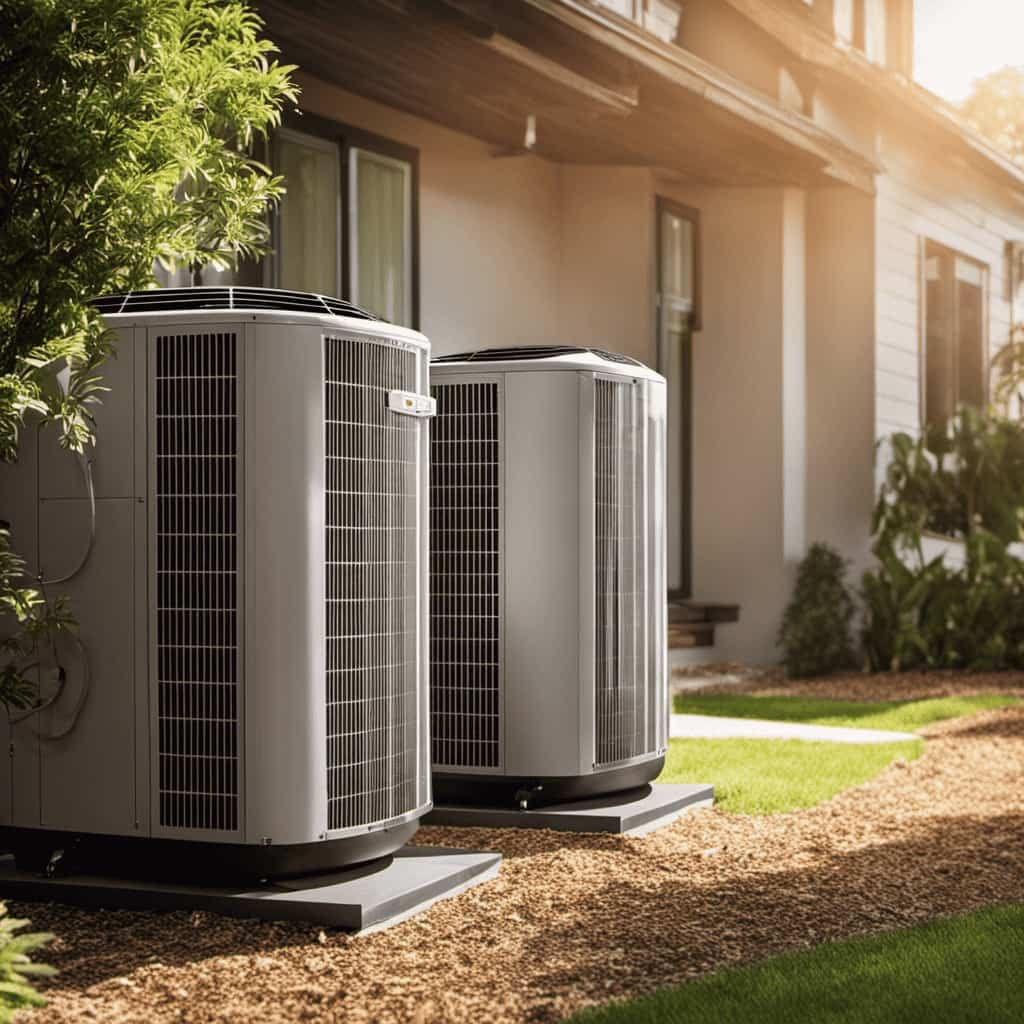
Factors Affecting Thermal Energy Transfer Efficiency in Geothermal Heat Pumps
One important factor that affects the efficiency of thermal energy transfer in geothermal heat pumps is the conductivity of the ground. The conductivity of the ground refers to its ability to conduct heat. Higher conductivity allows for better heat transfer between the ground and the heat pump system, resulting in improved geothermal heat pump efficiency.
Factors that influence the conductivity of the ground include soil composition, moisture content, and thermal properties. Optimizing energy transfer in geothermal heat pumps involves selecting locations with favorable ground conductivity and ensuring proper installation techniques to maximize thermal contact between the ground and the heat pump system.
Additionally, proper insulation and regular maintenance are crucial for minimizing heat loss and maximizing system efficiency. Understanding these factors and implementing effective design and optimization strategies can significantly enhance the thermal energy transfer efficiency in geothermal systems.
Effective Design and Optimization of Thermal Energy Transfer in Geothermal Systems
We can optimize the design and improve the thermal energy transfer in geothermal systems by implementing effective strategies and ensuring proper installation techniques.

To achieve this, we need to consider the following key factors:
-
System Sizing: Properly sizing the geothermal system is crucial for maximizing thermal energy transfer. This involves accurately calculating the heating and cooling loads of the building and selecting the appropriate capacity for the heat pump.
-
Loop Design: The design of the geothermal loop system plays a significant role in optimizing thermal energy transfer. Factors such as loop length, diameter, and configuration need to be carefully considered to ensure efficient heat exchange with the ground.
-
Heat Pump Efficiency: Choosing a high-efficiency heat pump is essential for maximizing thermal energy transfer. Energy-efficient models utilize advanced technologies and components to enhance heat transfer and reduce energy consumption.

-
Proper Installation: Ensuring proper installation of the geothermal system is crucial for optimizing thermal energy transfer. This includes proper insulation, sealing, and pressure testing to minimize heat loss and maintain system efficiency.
Frequently Asked Questions
How Does the Efficiency of Thermal Energy Transfer in Geothermal Heat Pumps Compare to Other Heating and Cooling Systems?
The efficiency of thermal energy transfer in geothermal heat pumps, compared to other heating and cooling systems, is superior. It meets regulation standards and has lower maintenance requirements, making it a reliable and cost-effective option for serving others.
Are There Any Regulations or Standards That Govern the Thermal Energy Transfer Efficiency of Geothermal Heat Pumps?
Yes, there are regulations and standards that govern the thermal energy transfer efficiency of geothermal heat pumps. These guidelines ensure that the systems meet minimum efficiency requirements and provide reliable and efficient heating and cooling.
Can the Thermal Energy Transfer in Geothermal Heat Pumps Be Affected by the Geological Characteristics of the Location?
Yes, the geological characteristics of a location can impact the thermal energy transfer in geothermal heat pumps. Factors such as soil composition and rock formations can affect the efficiency and effectiveness of the heat transfer process.

Are There Any Specific Maintenance Requirements for the Heat Exchangers in Geothermal Heat Pumps to Ensure Optimal Thermal Energy Transfer?
Maintaining optimal thermal energy transfer in geothermal heat pumps requires regular maintenance of the heat exchangers. By addressing any issues promptly, we ensure the efficient transfer of heat and the longevity of the system.
What Are Some Common Challenges or Obstacles That Can Hinder the Efficiency of Thermal Energy Transfer in Geothermal Heat Pumps, and How Can They Be Addressed?
Geothermal heat pump efficiency challenges can arise from obstacles that hinder thermal energy transfer. To address these, we must identify and rectify issues such as inadequate ground loop design, low refrigerant levels, and poor insulation.
Conclusion
In conclusion, understanding the principles of thermal energy transfer is crucial for maximizing the efficiency of geothermal heat pumps. These systems rely on conduction and convection to transfer heat, and their operation is based on thermodynamics principles.
One interesting statistic is that geothermal heat pumps can provide up to 70% energy savings compared to traditional heating and cooling systems, making them a sustainable and cost-effective option for maintaining comfortable indoor temperatures.

-

 Residential and Commercial Applications7 months ago
Residential and Commercial Applications7 months agoBest Amana Heat Pump Reviews
-

 Thermal Energy Transfer7 months ago
Thermal Energy Transfer7 months agoBreakthroughs in Modern Heat Pump Systems: Thermal Energy Edition
-

 Geothermal Heat Pumps6 months ago
Geothermal Heat Pumps6 months agoInnovative Geothermal Heat Pump Manufacturers Revolutionize Energy Efficiency
-

 Residential and Commercial Applications7 months ago
Residential and Commercial Applications7 months agoBest Heat Pump
-

 Geothermal Heat Pumps6 months ago
Geothermal Heat Pumps6 months agoUpgrade Your Comfort with Our Efficient HVAC Systems
-

 Air Conditioning5 months ago
Air Conditioning5 months agoExploring Energy-Efficient Air Conditioning Heat Pumps
-

 Energy Consumption4 months ago
Energy Consumption4 months ago10 Key Comparisons: Heat Pump Vs Traditional Heating
-

 Thermal Energy Transfer4 months ago
Thermal Energy Transfer4 months agoBoost Your Heat Pump Efficiency: Interactive Guide








